Which heating radiators are best for an apartment. Do-it-yourself installation of heating batteries
Do you know why radiators are ribbed or wavy instead of just round or flat? How might this affect the choice of radiator for your home? Find the answer in this article.
Photo: termonet.ru
Fact 1
A heating radiator works efficiently if its heat output corresponds to the area of the room (the term “heat transfer” is also used in the characteristics of radiators).
If you buy a radiator with much more power than you need, the room will be constantly overheated, which can lead to a decrease in air humidity and oxygen content in it. If the power is insufficient for a given area, you will freeze.
It is difficult to accurately calculate the required heat output of a radiator; there are special methods for this. Everything is taken into account: climate, building features, parameters of the thermal system. But this value can be approximately estimated as follows: for heating a room that has one medium-sized window and one wall facing the street, in middle lane RF for every 10 m² requires at least 1 kW. If you have a room of 12 m², you need a radiator with a heat output of at least 1200 watts.
So, one of the most popular models - aluminum Global ISEO 500 - has a heat output of 181 W per section. A radiator assembled from 12 such sections can effectively heat a standard room of about 20 m². The thermal power of the bimetallic Royal Thermo BiLiner 500, consisting of 10 compact sections, is 1710 W. The model was designed taking into account the requirements of aerodynamics for optimal distribution of air flows. Steel radiator Kermi 11 (panel) 110 cm long has a power of 1190 watts. Cast iron 7-section Konner - 1050 W and 56 cm long.
Fact 2
When choosing a radiator, you need to take into account the working pressure in the heating system at home.
The working pressure of most sectional steel and cast iron radiators is up to 9 atm, aluminum - more than 12 atm. The technical characteristics of bimetallic radiators indicate values \u200b\u200bthat exceed 30 atm. The margin (the difference between the indicators of the heating system and the radiator) is recommended to be taken at least 2 atm.
In urban high-rise buildings, pressure is maintained up to 9 atm, but it can be increased to 13 atm (during tests, for example). Therefore, for a city apartment, you need to buy an aluminum or bimetallic radiator.
Bimetal radiators are ideal for high and fluctuating pressure applications. Radiators from Global performed well - for example, the Global VOX-R 500 (aluminum) or Global Style Plus 500 (bimetal) model. They can be installed in residential, office and commercial buildings with any type of heating system (central, autonomous). When developing them, the technical features of Russian heating systems were taken into account.
Steel is recommended to be installed in private houses, in cottages, where the pressure in the heating system is small. Kermi radiators are often used in cottage construction. The Kermi FTV series has a built-in thermostat.
Fact 3
Water hammer can damage the steel radiator.
But solid aluminum racks to such influences. The material in them retains its natural plasticity, so the probability of a crack is low. For example, Elsotherm aluminum radiators (in particular, AL S 500/80) have been tested at 24 atm, so they are not afraid of pressure surges in domestic networks. They can be installed in buildings of any height and purpose.
Fact 4
The mass of the appliance determines whether the temperature in the room will change quickly.
The most massive radiators are made of cast iron. Therefore, their thermal inertia is great - they slowly heat up and cool down, temperature fluctuations are smoothed out. Steel and aluminum, on the other hand, heat up quite quickly and cool down just as quickly.
Fact 5
The ease of installation depends on the massiveness of the radiator.
Cast iron not only gives the radiator a high heat capacity and thermal inertia, but also complicates the installation and maintenance of the device. Aluminum and steel radiators weigh much less. One section of the 180W cast iron Retro 600 weighs 11.4kg, while the six-section aluminum Calidor Super 350 with over 800W heat dissipation weighs only 6.72kg. Not big weight and dimensions facilitate the installation of the device and its possible repair.
Fact 6
The material from which the radiator is made determines the sensitivity of the device to the quality of the coolant (as a result, reliability and durability).
Water is used as a heat carrier in our houses. If the radiator is demanding on its quality, then it can only be installed in heating systems with good water treatment.
For a cast iron radiator, the quality of the coolant does not have of great importance. Cast iron, from which the parts are made, is sufficiently resistant to corrosion. But with long-term use in a network where the water is not cleaned very well, plaque forms on the inner walls of the radiator channels (due to the fact that the surface is porous, rough), and this leads to a decrease in heat transfer.
Steel panels are produced from low carbon steel, which has good corrosion resistance. But in open systems (in which the tank for draining excess coolant has an open design - in this case, the entire heating system is in direct communication with the atmosphere), steel radiators become prone to corrosion. Therefore, steel radiators are used in closed systems.
Aluminum in water does not corrode if the film formed on its surface is not broken, which excludes direct contact of the material with water.
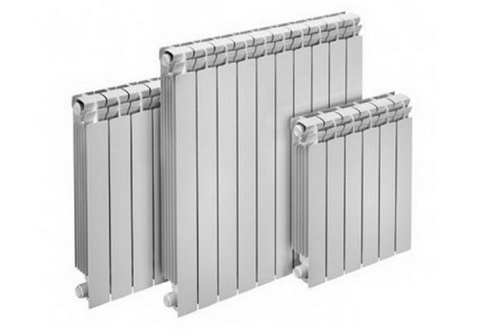
Photo: samara.propartner.ru
To protect aluminum radiators on inner surface pipes are coated with a special polymer coating during the production process. It increases the resistance of the surface to corrosion, prevents the formation of plaque and clogging of the pipe lumen. For example, the Italian model Calidor Aleternum Super 500 has a unique coating developed by Fondital. Radiators with a protective coating last longer (up to 15 years), can be used in heating systems with high acidic or alkaline indicators of the coolant: Aleternum allows operation at pH 5-10. Radiators of this series are recommended to be installed both in urban high-rise buildings and in private houses.
The reliable bimetallic Rifar Monolit is guaranteed by the manufacturer for 25 years. Channels for the coolant are made of steel with increased resistance to corrosion. One-piece design ensures the strength of the device, the ability to work at pressures up to 100 atm (test - 150 atm). There are no intersection joints. To the type of coolant, to the quality of preparation, this model is absolutely undemanding, it can work with enough high temperature— up to 135°.
Fact 7
Copper fittings must not be installed with aluminum heating radiators.
The destruction of aluminum under the action of water is greatly enhanced if the radiator parts are in direct contact with copper. Therefore, when connecting aluminum radiators, steel connectors, plugs, etc. are used.
Fact 8
The presence of interconnections and gaskets in the radiator housing adversely affects its reliability.
When buying, you should pay special attention to the quality of the connections and gaskets. Connections are a weak point in the design of the device. Even in cast-iron radiators, intersection gaskets and nipples can collapse. Steel sections and tubes are welded together, so such devices are much stronger and more durable. The probability of leakage in a solid radiator is much less.
Fact 9
The heat output of a radiator depends on its total surface area.
The larger the heated surface of the device, the more heat it is able to give to the room. The area is increased not only by changing the length and width of the hull, but also by adding ribs and protrusions. Steel panels are often bundled together.
Fact 10
The heat output of the radiator may be reduced if the appliance is installed incorrectly (very low, too close to the wall).
A significant part of the heat the radiator gives off by convection. Therefore, there must be enough space around the instrument housing for air movement. It is recommended to leave 10 cm of free space above and below, 4 cm to the wall.
Fact 11
Solid radiators cannot be extended.
In an aluminum radiator, the sections are interconnected using nipples. The excess can be removed, the missing one can be added, and the damaged one can be replaced.
Fact 12
The thermal efficiency of radiators depends on how the coolant is supplied and removed.
Radiators have a universal design or allow only the top, only the bottom connection to the system - this should be taken into account when choosing. The heat flow from the device increases if water is supplied to the upper part and discharged from below. Coolant supply from below and removal from above reduces heat transfer by almost 20%.
Fact 13
Radiators have different center distance, different type connections.
You also need to know all these parameters of your network. Are there pipes (inlet and outlet) in your room on one side of the radiator or on the opposite side? How far apart are they? What diameter do they have?
Fact 14
The use of a decorative screen reduces the thermal efficiency of the radiator (by 15-20% on average).
The shield protects the battery from dust and damage. If you know in advance that your radiator will be covered with a decorative screen, choose a model with a higher thermal output. Decorative grilles and perforated screens reduce heat transfer less.
Fact 15
If you live in an apartment building, it is possible to replace heating radiators with appliances of a different type and with different parameters only after agreement.
The heating system is included in the concept of "common property" of the house. Heat is distributed to all apartments and common areas in the house. The system is designed so that the heat supplied is enough for everyone, so that the desired temperature is maintained everywhere. The design of the heating system of the house (including radiators) is described in the approved project documentation.
Now imagine that a radiator was installed in one of the apartments, which requires much more coolant than the standard ones in this house. The system will be broken, other consumers may suffer. This is just one of the examples. Therefore, before paying for new heating radiators, you should contact your management company(HOA board, etc.), find out if the selected device can be installed in your apartment, and agree on its installation.
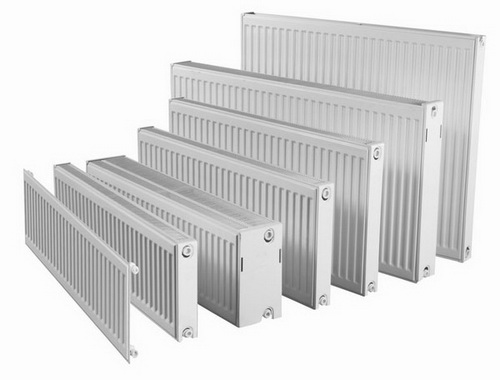
Photo: termonet.ru
Summarize. Radiators are made from different materials, and this material determines the suitability of the appliance for inclusion in your heating system. Before buying, you need to find out the parameters of the coolant and the entire system in your house, calculate the heat output you need, provide for the location of the device and coordinate the work with the specialists of the management company.
Heating radiators: which are better for an apartment
Summer is the time for repairs in our apartments, this is the time to refresh the faded wallpaper, to make a fashionable false ceiling and much, much more that was included in our plans.
But, if you have a centralized heating system in your house, which, as a rule, also rests in the summer, then it's time to replace the old heating radiators that have served you faithfully with new ones that are modern in design and meet all safety requirements. But it is not always clear which radiators are best for an apartment.
By the way, I would like to say about our centralized heating system: on the one hand, it has more than enough advantages, but it also has its drawbacks. There is no need to install an expensive one in the house, and constantly monitor its work, adjusting and configuring it.
This is the main plus of the very system that will be discussed today. Autumn will come, and the hot coolant will “run” through the battered pipes of our houses and provide us with warmth and comfort. Nothing needs to be controlled and regulated, the system works by itself, without requiring our intervention. And here it will not be superfluous to recall the disadvantages of centralized heating, and they are not as harmless as it turns out.
Coolant, i.e. water, passing a fairly long way from the CHP, where it is heated, to each specific radiator, is saturated with substances of chemical origin present in it, which corrode both pipes and batteries from the inside.
In addition to liquid harmful impurities, water carries with it small particles of solid impurities, the so-called sludge, and our batteries not only corrode, but also receive mechanical damage, up to the formation of a hole.
Aluminum and bimetal radiators Royal Thermo
The water in the radiator often changes temperature, which is also not very useful for the metal. But, the most dangerous thing that can happen to our heating devices is a sharp pressure drop that happened due to air getting into the pipes or due to the inattention of a locksmith who was smart with the valve.
As a result, a water hammer can occur with a battery rupture, a fountain hot water from it and all the other problems that are unpleasant for you and your neighbors from below. Therefore, it is recommended to install in a radiator.
After all of the above, I think no one needs to be convinced of the role that correctly selected heating radiators play for us. Which is better for an apartment, and by what criteria you need to choose this device, we will talk today, based not only on reviews, but on facts.
Criteria for choosing a heating radiator for an apartment
1. The metal from which it is made, because. Each metal has its own physical and chemical properties.
2. An important criterion is the ability of the metal to withstand one or another Atmosphere pressure which must be specified by the manufacturer of the product.
If you live in an old panel "Khrushchev", then the pressure indicator of your radiator should not exceed 5-8 atmospheres, and if you are a resident of a multi-storey modern building, then your batteries must withstand an operating pressure of 12-15 atmospheres.
3. The metal from which the radiator is made must be safe with a sharp jump in pressure and save you from water hammer.
By the way, the first harbingers of this blow may be a rumble and other extraneous noises in the battery, therefore, having noticed violations, urgently call the master.
4. Knowing what kind of water flows through our pipes, choose a radiator made of a material that is not subject to corrosion and other damage, because many devices are coated from the inside with a special substance that protects them from chemical and mechanical damage.
5. Good heat dissipation is the main indicator of the efficiency of any heating device.
6. Shelf life: the longer it is, the less often you will have to update your batteries, and this will save not only material resources, but also your nerves.
7. The appearance of the radiator must match the style and design that you have preferred, and this possibility is now available, since the choice of devices on the market is really rich and varied.
So, having weighed all the pros and cons, guided by reviews, advice from friends and articles on the Internet, correlating your desires and possibilities, you make a choice. Modern radiators are made from different kind metals and even alloys that have certain advantages and disadvantages that you need to know about.
The most popular and affordable of them are radiators, steel or cast iron, as well as floor and baseboard convectors.
Steel radiators There are two types: panel and tubular.
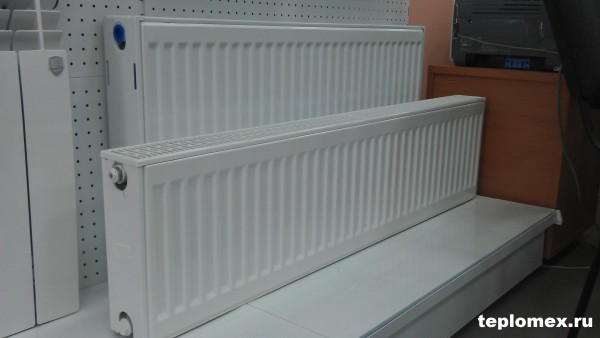
Kermi steel panel radiators
Positive properties of panel radiators:
– high level of efficiency up to 77%
- excellent heat dissipation;
— guarantee of environmental safety;
- low price.
Although on the market you can find products of well-known brands made in Germany, Russia or Italy, the prices for radiators are kept at a quite affordable level. Here we can recommend manufacturers such as or.
Disadvantages of steel panel radiators:
— subject to corrosion;
- the impossibility of their use in buildings with a high number of storeys due to the threat of water hammer;
- convection, characteristic of this type of radiators, contributes to the occurrence of drafts and the movement of dust;
Advantages of tubular steel radiators:
– working pressure from 8 to 15 bar, which is higher than the working pressure of panel steel radiators;
- higher heat transfer;
- corrosion protection.
Comparing these 2 types of steel radiators with each other, you can see that, in principle, both their positive and negative sides are almost the same: having better performance in terms of working pressure, tubular radiators are much more expensive.
Features of aluminum heating radiators
Aluminum radiators are also produced in two types: cast - made by casting, and extrusion - made by extruding an aluminum alloy through an extruder.
The cast radiator has wide, strong walls, and the extruded one, for all its positive qualities ah has a big drawback: it cannot increase or add the required number of sections.
Positive qualities of aluminum radiators:
- light weight, easy installation;
- high level of heat transfer;
- the ability to quickly warm up the room;
- economy when possible
Disadvantages of aluminum radiators:
- fragility (the service life of these batteries does not exceed 15 years);
— susceptibility to corrosion;
- tendency to form leaks .;
- no protection against water hammer during a pressure surge
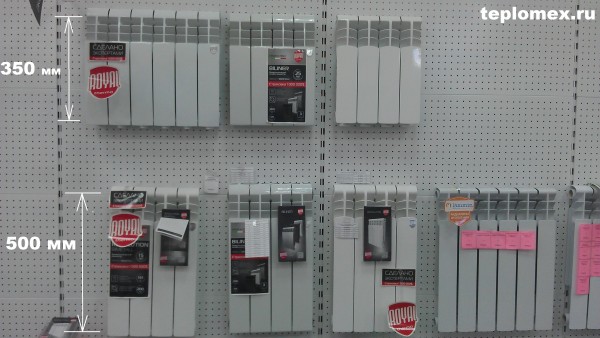
The choice of heating radiators
General technical characteristics of aluminum radiators:
- pressure from 6 to 16 bar;
- the maximum water temperature in the radiator is + 110 degrees;
There are many different manufacturers of aluminum radiators on the market. From inexpensive Chinese "Lammin" or "Konner", Russian "Rifar" radiators, to Italian and better ones from "Royal Thermo" or "Global".
Features of cast iron radiators
- ease of installation;
- economy;
- Possibility of temperature control.
Cons of these radiators:
- requires the skills of a specialist to install them;
- wall decoration is broken;
- a very high price.
Watching video
Here are the main parameters and technical characteristics of radiators made from different types of materials. We examined the advantages and disadvantages of cast iron, steel, aluminum and bimetallic radiators, despite different reviews. Dismantled together what radiators are best for an apartment and private house. Choose, taking into account the living conditions and your financial capabilities.
When starting a major overhaul in the house, or equipping a heating system from scratch, a reasonable question arises, which radiators are better to buy? In modern stores today there is a huge selection of radiators. But according to what characteristics should they be selected? In this article, we will consider the main heating radiators, which are better for an apartment in terms of efficiency and comfortable microclimate.
If you need to calculate the number of heating radiators, we recommend that you read this material.
Heating radiators - which are better for an apartment
In this article, we will compare the main technical characteristics of heating units, compare them with the requirements of the central and autonomous system heating and determine which option will be the most economical and efficient.
Features of the central heating system
The requirements for choosing one or another radiator are mainly formed by the heating system. Most apartments in our country are served by a central heating system, which has a number of its pros and cons.
If apartments in your house are connected to a single central heating system, then the heat unit must be selected taking into account its technical features. First, let's define what a central heating system is.
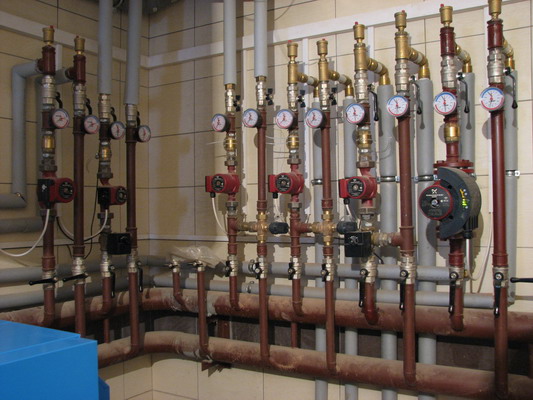
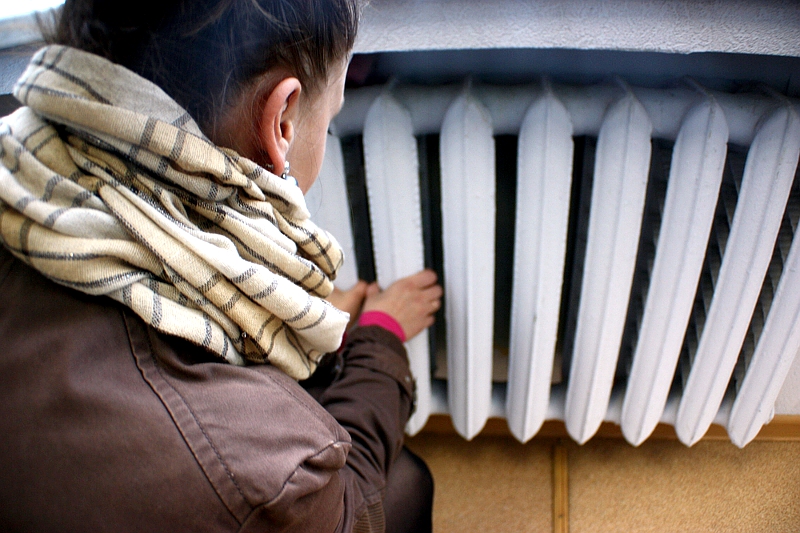
As you can see, the central heating system makes rather high demands on the quality of radiators. Many modern batteries are simply not designed for the quality of the coolant that runs through the pipes and the pressure created in the pipes.
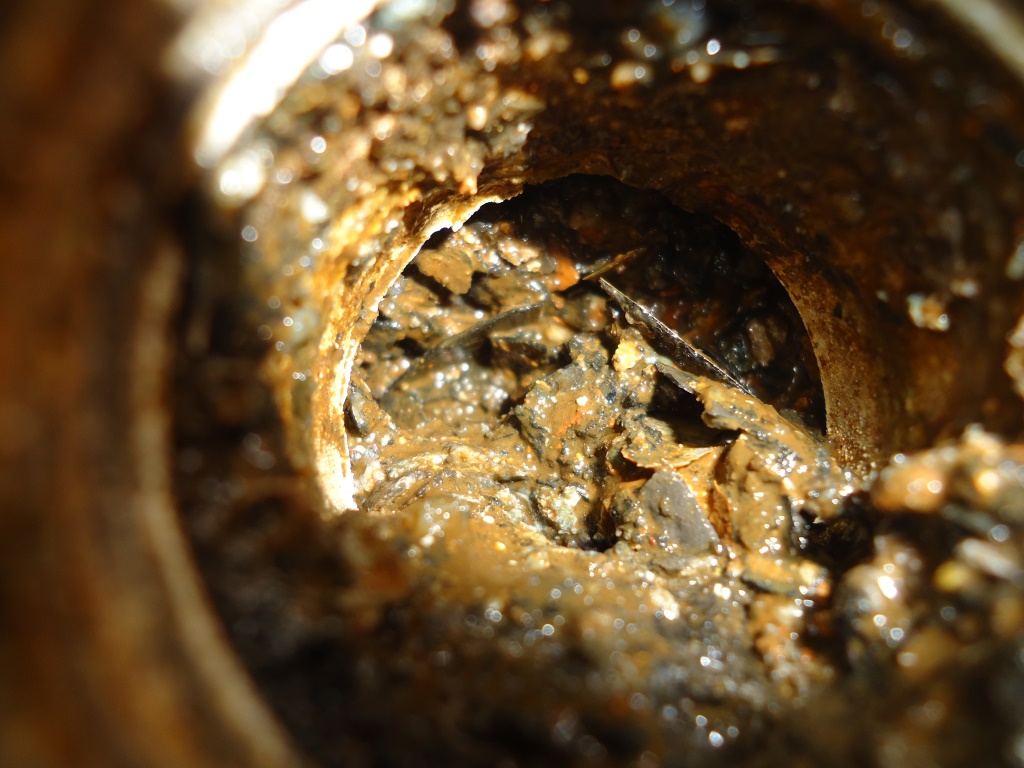
After we have clearly formed the features and operating conditions of batteries in apartments with a central heating system, we can proceed to their selection.
Types of radiators
Today, there is a wide variety of heating devices on the market, which differ in appearance, material and technical parameter. As a rule, it is the material that determines the main differences between radiators.
- Cast iron.
- Aluminum.
- Steel.
- Bimetallic.
- Copper.
Cast iron radiators
This type of battery is familiar to all of us, if only because absolutely all Soviet apartments previously had bulky batteries. cast iron batteries.
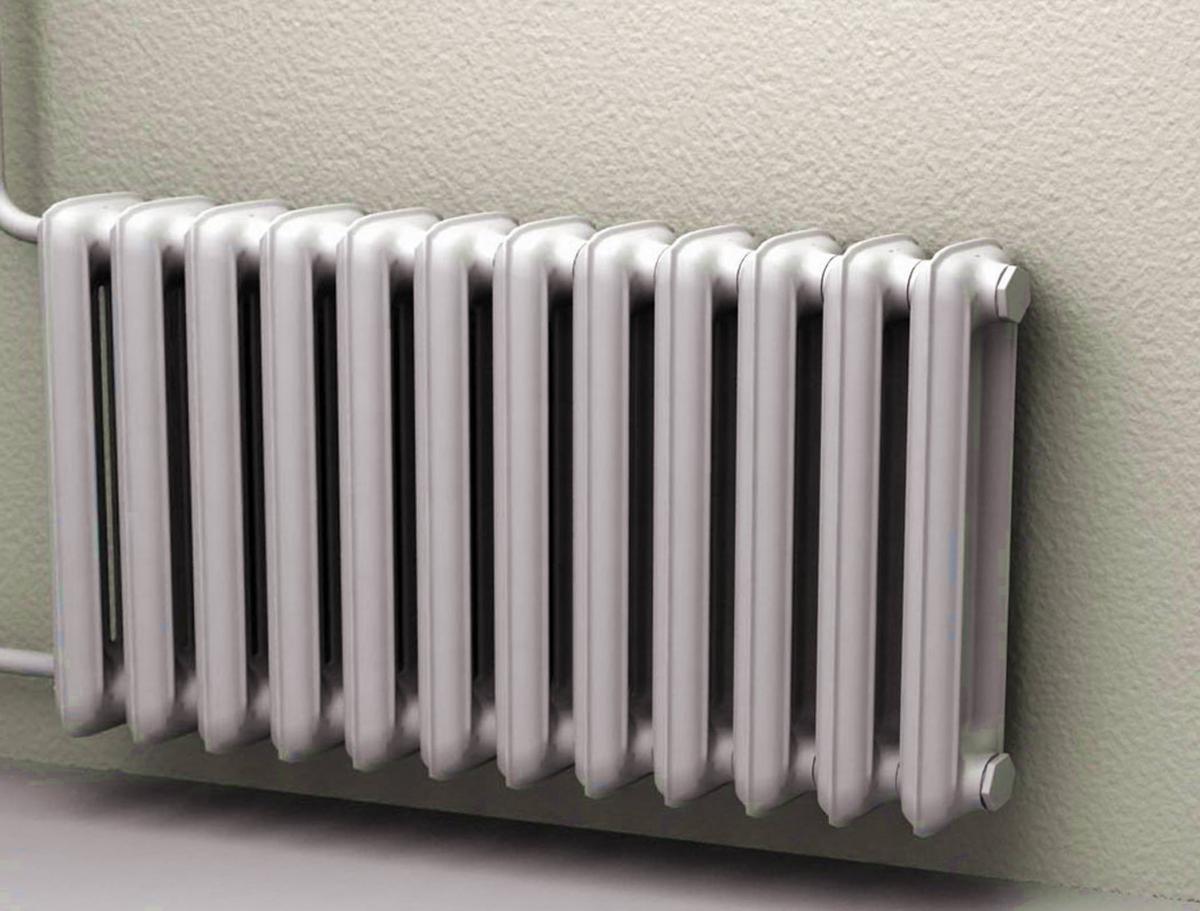
But today, these heavy, standard-sized structures painted with enamel paint are a thing of the past. They are being replaced by stylish counterparts.
More stylish, powerful and efficient, today they seriously compete with modern analogues. Cast iron has excellent thermal conductivity, it heats up for a long time, but at the same time it cools down just as long. Even after the temperature in the system drops or even after the coolant is turned off, such a battery will give off its heat for some time.
The residual heat retention number of cast iron radiators is 30%, which is twice that of steel and aluminum products.
Cast iron is a very durable and reliable material that can withstand a working pressure of 25-30 atmospheres. Given the average of 16 atmospheres, such batteries are not afraid of even powerful water hammer and failure of the central coolant.
Another feature of cast iron batteries is their versatility. They can work with pipes of any material. Thus, when purchasing cast-iron radiators for an apartment, you will not need to change the entire piping system.
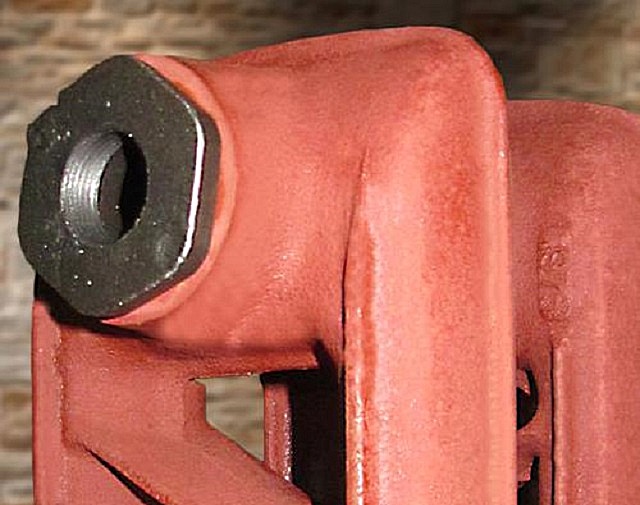
As for the quality of the coolant, cast iron batteries are perhaps the most unpretentious in this regard. A thick layer of cast iron is not subject to corrosion, which means that such radiators will last for decades in an apartment where the pH of the water fluctuates between 7-9 units.
As a result of prolonged interaction with water, a black precipitate gradually forms on the inner shell of the cast-iron radiator. It is he who creates a protective film that prevents the penetration of oxygen to the metal. If all technical standards of operation are observed, then the failure of cast-iron batteries due to metal destruction is extremely rare.
Modern cast iron radiators are coated on the outside with a special protective paint at the factory. At home, there will no longer be a need to paint them every year.
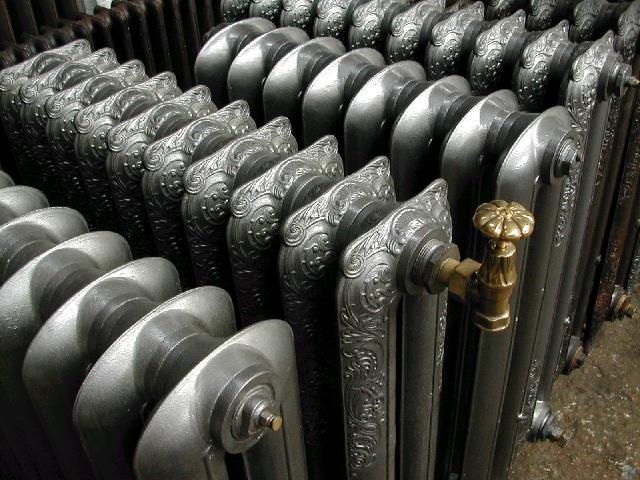
The smooth surface makes it easy to clean and dust does not accumulate on them. In addition, cast iron batteries practically do not form gases, which guarantees easy maintenance. There is no need to constantly bleed air by removing air pockets.
If earlier, in Soviet times, it was possible to purchase cast-iron batteries of only one size, today manufacturers offer a wide variety of these units, distinguishable in size and appearance.
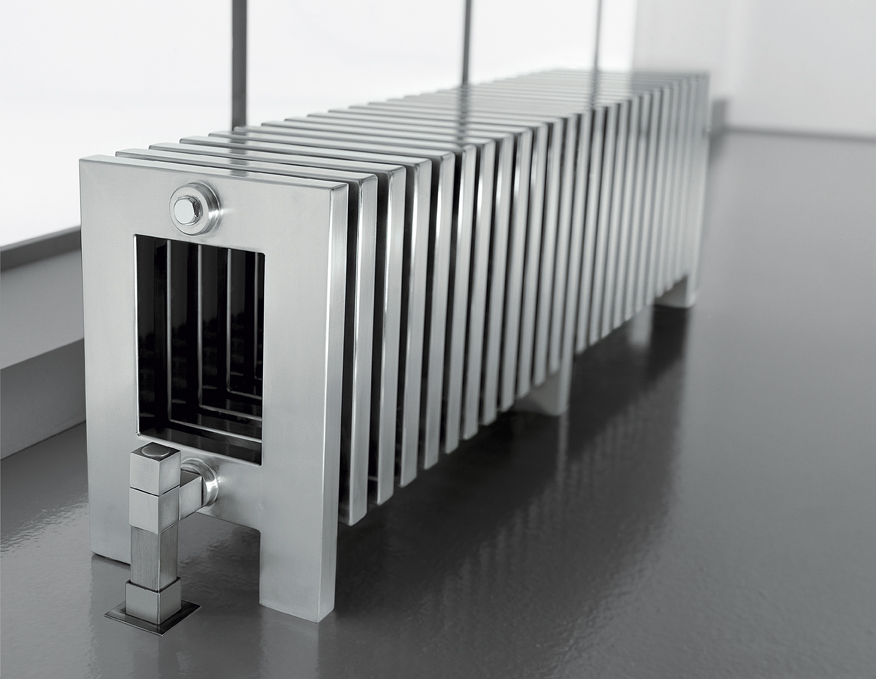
This will greatly expand your choice, helping you to choose stylish radiators for the design of the room and for creating the optimal temperature regime in the room. Foreign manufacturers offer very original design solutions in retro style, decorated with ornaments and castings.
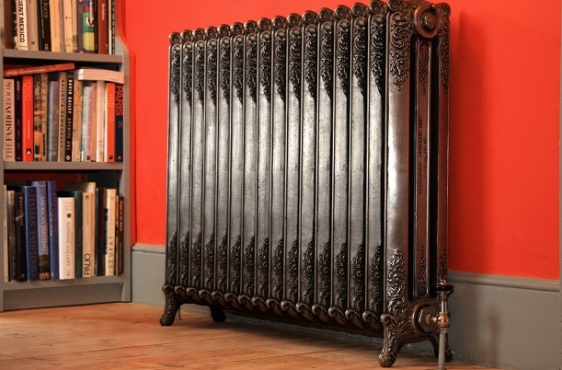
Depending on the size of the room, the cast iron structure can be built up. The required number of sections is selected based on the following parameters: the number of windows, doors, room area and climate zone. If in domestic designs the filling volume is 1.3 liters, then foreign companies offer cast-iron radiators with a volume of 0.8 liters. The most popular foreign manufacturers that offer the best value for money on the domestic market today are Konner, Roca, Demir, Guratec, Retro Style, Demir Docum. Russian and Belarusian MS-140 and BZ-140 batteries are not inferior in performance, but their price will be 2-3 times lower than foreign manufacturers.
If earlier, to install a cast-iron radiator, it was necessary to hammer a powerful bracket into the wall, damaging the finish, today many manufacturers produce stylish floor-mounted radiators.
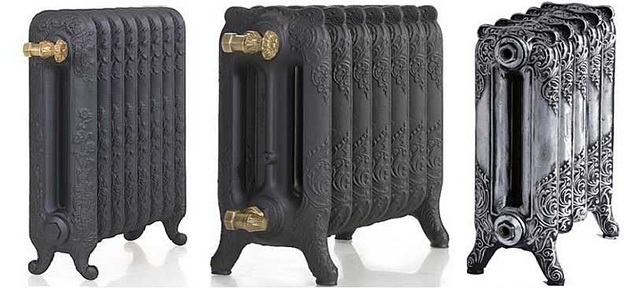
But, speaking of cast-iron batteries, it would be unfair not to mention some of their shortcomings. These products are extremely heavy, which greatly complicates their installation. To mount the battery to the wall, you need to use bulky brackets, which does not always fit into the overall style concept of the room. In addition, no matter how stylish they are, not all products made from this material will fit into the modern design of the apartment.
Cast iron has a very weak inertia. Yes, it cools down slowly, but this is not always an advantage. With such a radiator, it will not be possible to quickly adjust the optimal temperature in the room. For houses with an individual heating system, it is this property of cast-iron batteries that can become decisive. The operation of such products will turn out to be too expensive.
So, summing up, we highlight the main pros and cons of cast iron batteries:
- low cost;
- high strength and reliability;
- versatility and compatibility with pipes of different materials;
- simple operation;
- low requirements for the quality of the coolant;
- corrosion is not formed;
- long-term operation.
- great weight;
- weak inertia;
- installation complexity.
If you still decide to independently install cast-iron batteries in your apartment, then you will be helped to do everything right.
aluminum batteries
In spite of stylish design and attractive appearance, it is not the most the best choice for apartments with central heating system. At least in our country. The fact is that aluminum, due to its natural features- very thin material subject to corrosion. And, given the low quality of the coolant in our heating systems, already after 5-7 years of operation, these radiators may fail or their efficiency will decrease.
In apartments with autonomous heating, such designs are very popular due to high heat transfer and stylish appearance.
Today, one of the most interesting manufacturers of aluminum heating radiators in terms of "price / quality" is the STOUT brand. The products are made in Italy, they are adapted specifically for the operating conditions in Russia, they are suitable for working with antifreeze, they have modern design in Italian tradition, 10 year manufacturer's warranty.
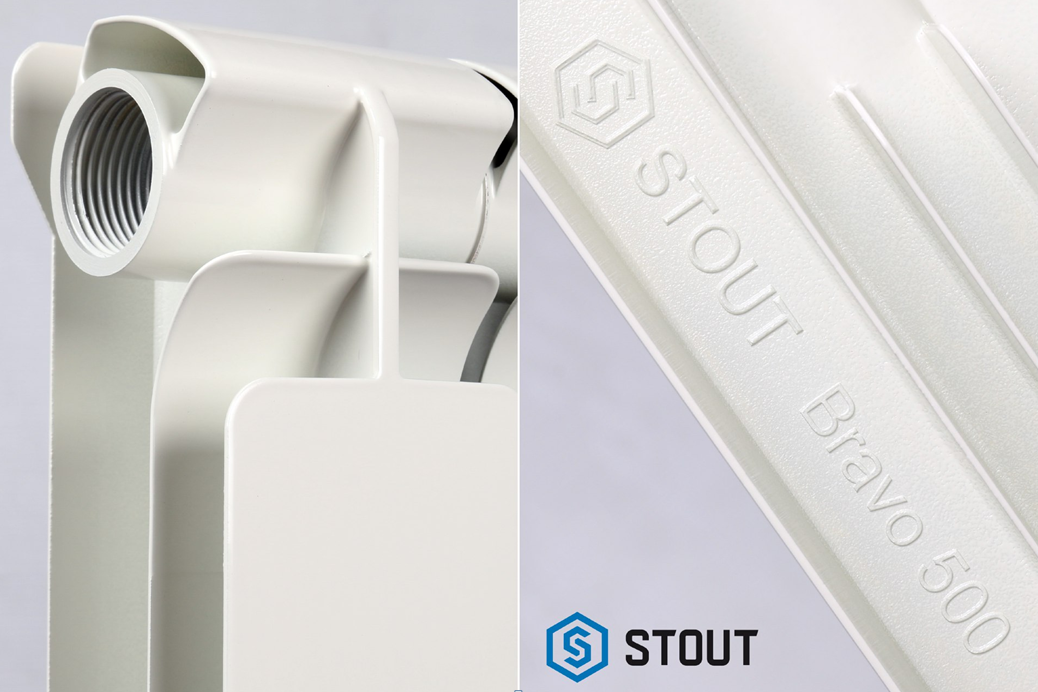
![]()
In this case, aluminum batteries can last at least 20-25 years, delighting owners with their functionality and beautiful design.
Aluminum batteries are designed for an operating pressure of 15-20 atmospheres, which is quite suitable for a central heating system. But the main danger lies in the low resistance to water hammer, which our systems sin with. In addition, the test pressure figure stated in the passport is often far from reality in reality, and such radiators can normally function at an operating pressure of only 12 atmospheres.
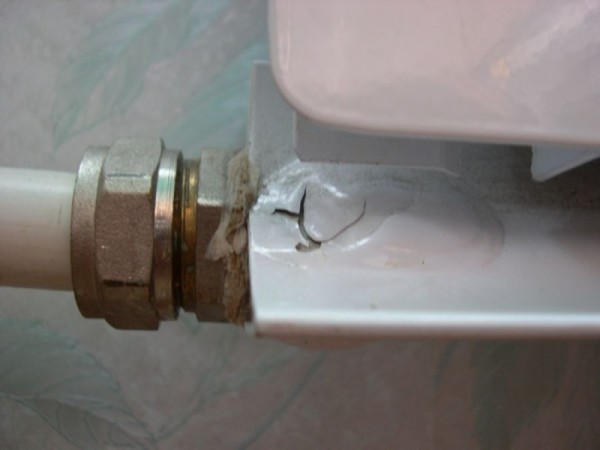
If the choice still falls on aluminum batteries, then experts recommend installing a conical shut-off valves. This will gradually increase the pressure of the coolant in the system.
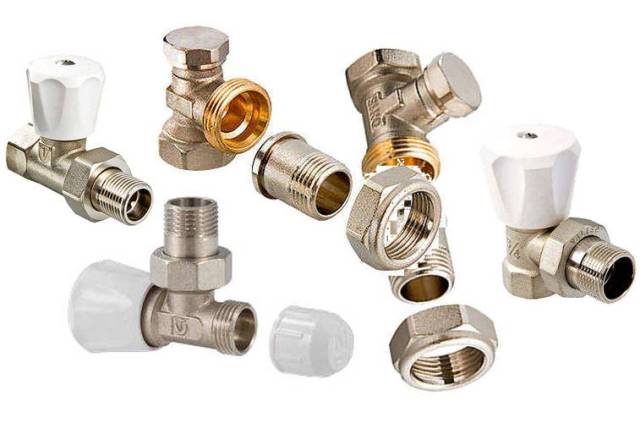
In addition, aluminum radiators have very strict requirements for the quality of the coolant. Normally, they will be able to function only with a Ph index of 5-6 units, which is far from the realities of domestic coolants.
Given the light weight of the structure, installation is not difficult even for one person. But here, too, some features must be taken into account. When connecting to the heating system, do not use brass, copper or steel fittings. When interacting with these types of metal, corrosion occurs in aluminum. Therefore, ideally, aluminum batteries should be connected to plastic pipes using grounding. The fastening of the structure with the system occurs by the method of threaded coupling.
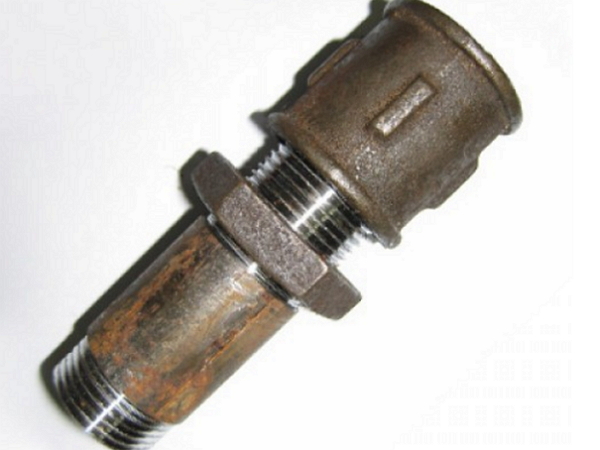
In the central heating system, there is a high oxygen content in the coolant. Reacting with aluminum, oxygen is converted to hydrogen gas, which causes unpleasant sounds in batteries and the formation of air pockets. One air lock can paralyze the operation of the entire system, therefore, in such radiators, a Mayevsky crane (air regulator) must be installed without fail so that air can be manually bled.
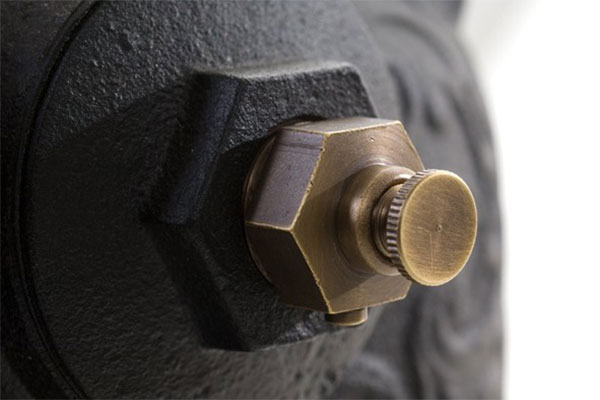
Aluminum has the lowest inertia of all metals, which provides it with a very high heat transfer. It is 200-210 W per 1 section of the battery, while the volume of each section is only 400-450 ml of water. These batteries are mainly designed for an operating temperature of 70-80 degrees. The maximum is - 90 0 С.
There is a wide range of aluminum radiators on the market today, which differ in design, shape and size. The standard distance between the upper and lower axis of the device can be 250, 350 and 500 mm. But if the parameters of the apartment allow, then you can order a non-standard size of 700-800 mm.
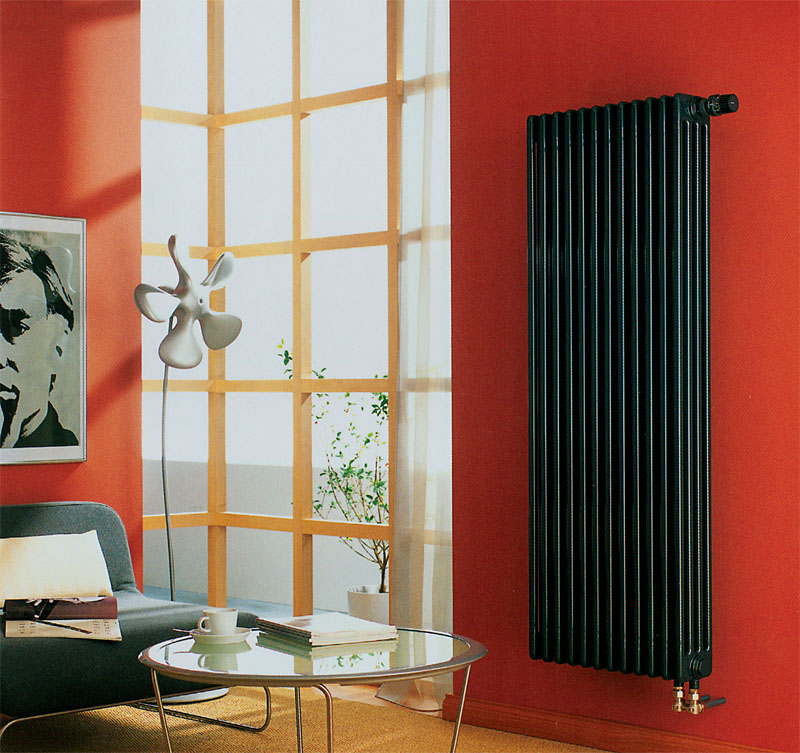
Aluminum radiators are perfectly "friends" with various types of thermostatic devices, so it will not be difficult to choose a device that will allow you to regulate the optimal temperature in the house.
This type of radiators is made from an aluminum alloy and various silicon additives that increase the technical properties of the units, but two completely different ways: casting and extrusion.
The injection method involves the manufacture of each section separately. An alloy of metals is poured into a special mold, which ensures perfect tightness of each section. This increases their working pressure to 16-18 atmospheres. During production tests, a test pressure of 22-25 atmospheres is created in the system, which indicates a large margin of safety for the product. For better heat dissipation, cast products generally have a smooth surface, which greatly simplifies the maintenance of the structure.
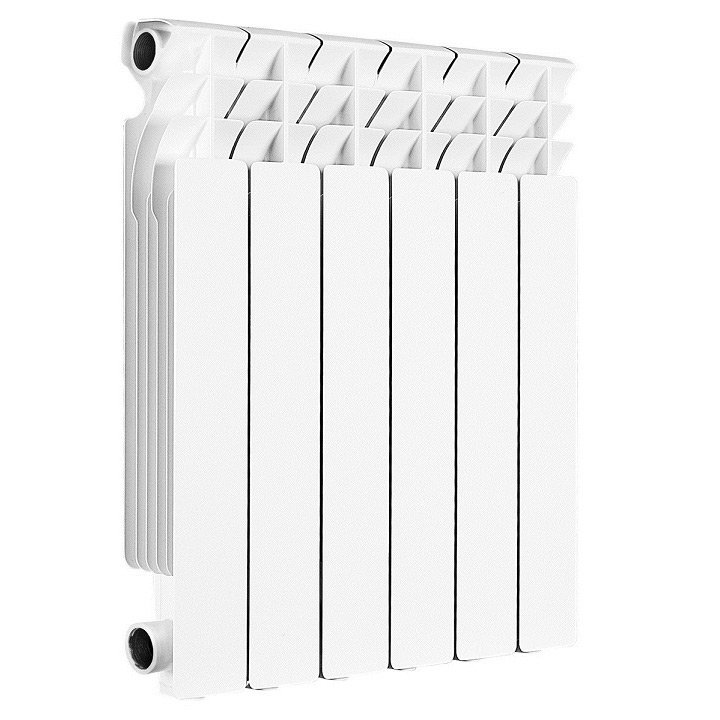
Aluminum radiators made using extrusion technology are several times cheaper, but at the same time they are inferior in terms of technical specifications their cast counterparts. Here, as a raw material, already secondary (recycled) aluminum alloy with silicon additives is used. A lower composition suggests the presence of additional impurities, which increases the brittleness of the metal and reduces its resistance to corrosion.
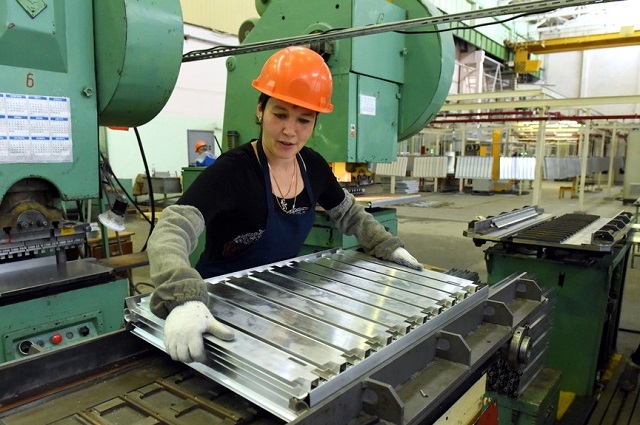
Extrusion technology involves forcing individual sections of the product through special nozzles. Then these sections are assembled into a finished structure, but during operation it will not be possible to increase or decrease the size of the unit.
Pros:
- light weight (they are almost 4 times lighter than cast iron products);
- simple installation;
- stylish appearance;
- variety of colors and sizes;
- low price;
- high heat dissipation.
Summarizing the disadvantages of aluminum radiators, I would like to once again emphasize that all these disadvantages appear precisely when installed in apartments with a central heating system. In houses with autonomous heating, these shortcomings will not be of such importance.
Minuses:
- low resistance to hydraulic shocks of the system;
- high requirements for the quality of the coolant;
- hypersensitivity to various abrasive substances in water;
- working pressure should not exceed 12 atmospheres;
- frequent "airiness";
- low service life.
Summing up, we can conclude: despite their compactness, neat appearance and light weight, aluminum radiators are not the best choice for apartments with a central heating system.
Another separate item in aluminum units can be distinguished products with anodized coating. They are also made from a high-quality alloy of purified aluminum and silicon compounds, but the surface of the devices is covered with an oxidized anode.
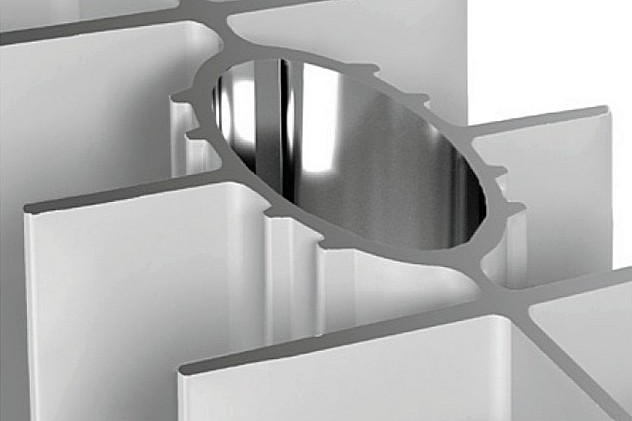
During the production process, aluminum changes its structure several times, which significantly increases its wear resistance and resistance to corrosion. Such batteries are not afraid of the aggressive environment of even low-quality coolant.
Anode batteries are produced by casting, and already finished sections are assembled into a common design using reliable seals and a threaded coupling. The advantage of such units is that they can be disassembled to remove a damaged section or to build up any battery size.
The inner surface of anodized radiators has a perfectly smooth structure, which significantly increases the efficiency of heat transfer. The coolant circulates freely inside the structure, and the operating pressure can reach up to 20-25 atmospheres.

But with the purchase of anode batteries, you need to be extremely careful. Indeed, in their appearance, they are no different from ordinary cast aluminum radiators. Only a passport and a quality certificate can indicate the chemical composition of the material. Therefore, you need to purchase such products, which are distinguished by a high price, only from trusted sellers.
Anodized batteries are also perfect for apartments with central heating. The high price quickly pays off due to long-term operation, good efficiency and heat dissipation of products.
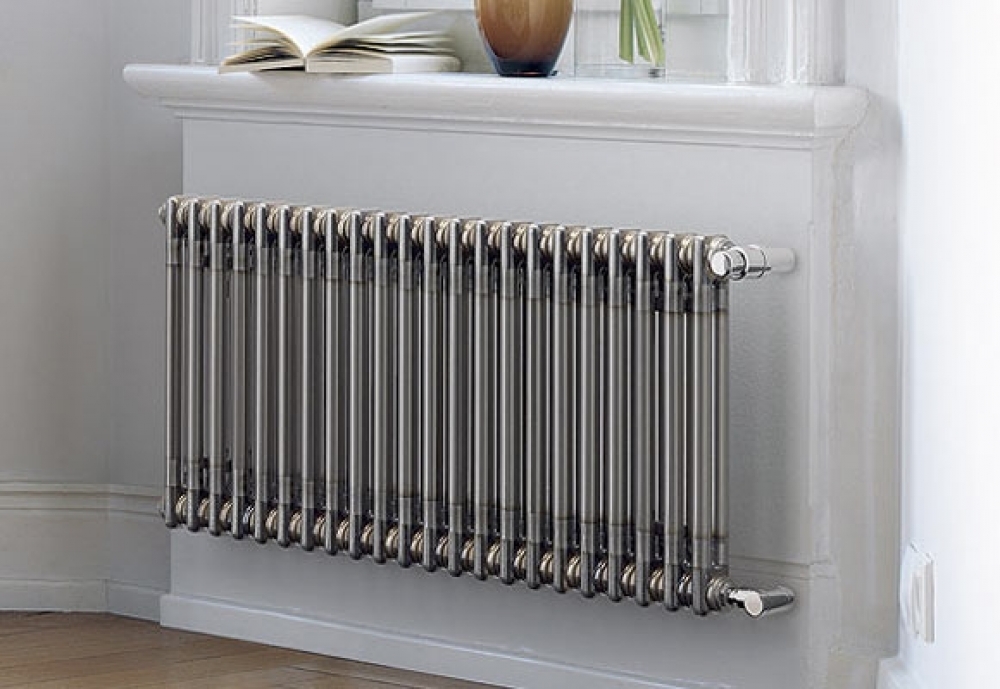
Modern steel batteries differ from each other not only in design, but also in construction. There are two types of such batteries: tubular and panel. To understand which version of steel batteries is better to purchase for an apartment, let's look at the features of each design separately.
Panel steel batteries
This type of radiator consists of two ribbed plates, produced by casting, inside of which there is a hermetically welded circuit. It is he who is filled with a coolant and provides the supply of hot air to the apartment.
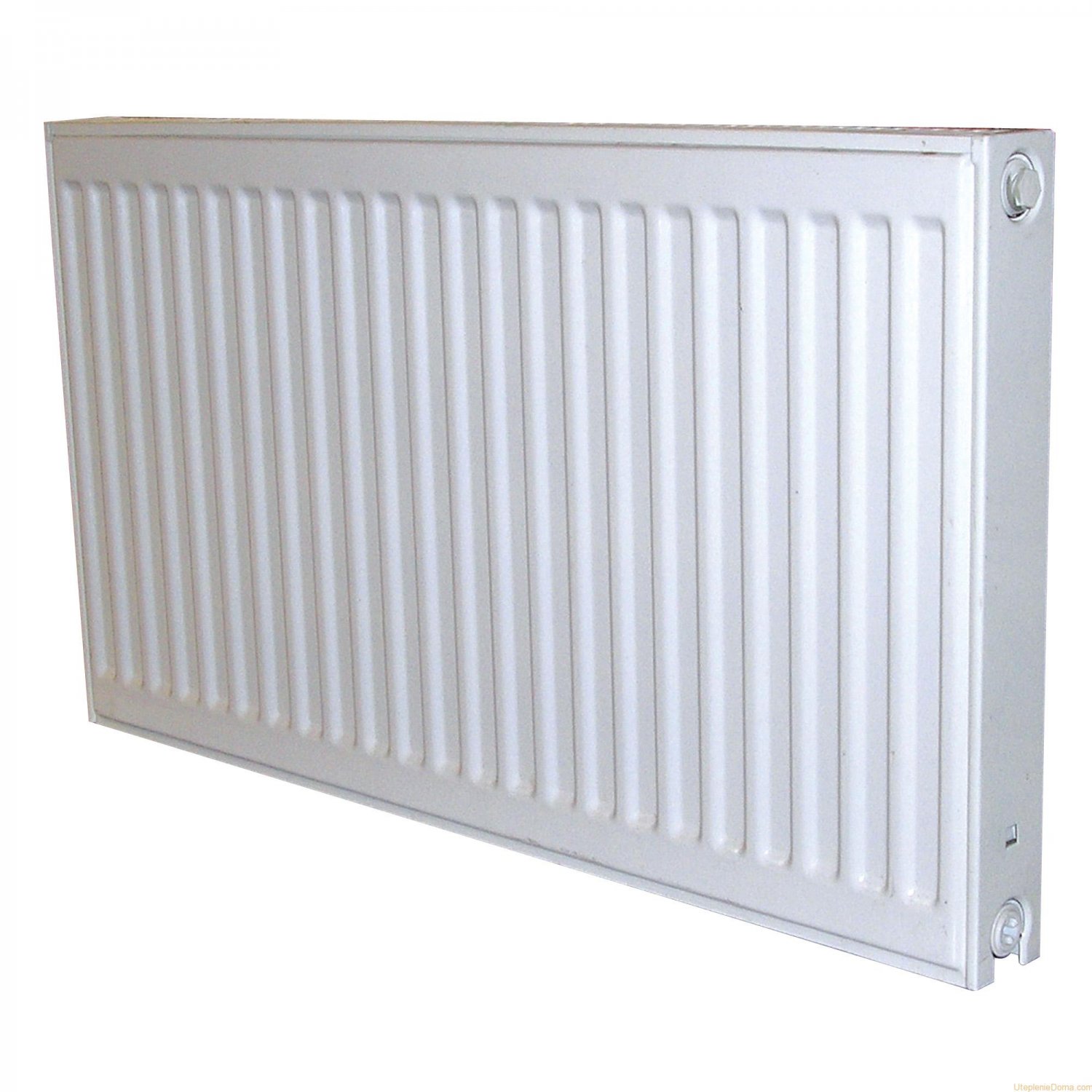
The ribbed shape of the steel battery provides efficient heat dissipation and circulation warm air indoors. Steel has the same thermal conductivity as cast iron. But unlike the thick walls of cast-iron radiators, steel units warm up much faster. In order to warm up a cold apartment from scratch, they will need 2 times less time. This high performance is achieved due to convection, which accounts for almost 50% of thermal radiation.
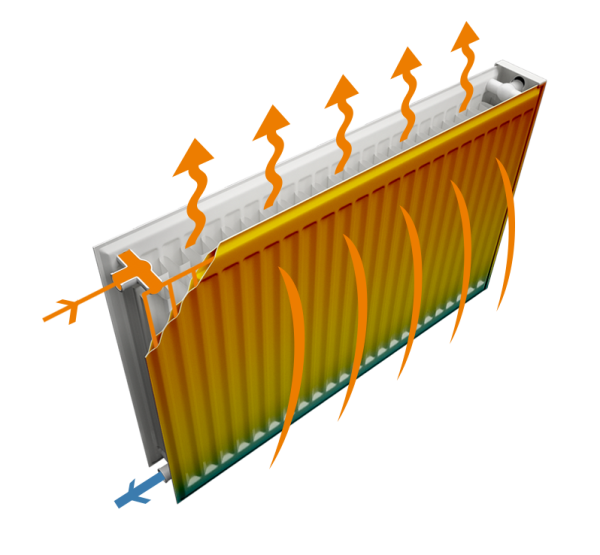
Steel batteries are designed for an operating pressure of 10-11 atmospheres, which is quite suitable for a central heating system. Manufacturers equip some models with convector elements (special vents) that create a thermal curtain for cold air coming from a window or door. Cold air is taken in from below and passes through the panel vents.
After assembling the panel, the entire structure is covered with a special protective paint, which provides reliable protection against mechanical and chemical damage. When buying, carefully check the uniformity of the paint application. It is this nuance that can affect the duration of the operation of products. Areas that are poorly painted over with protection can cause corrosion.
Standard steel panel radiators are designed for a coolant of 85-90 degrees, but if necessary, they can withstand temperatures up to 100-110 degrees. To the quality of water, such units present minimum requirements. It is clear that steel is susceptible to corrosion, but the permissible pH threshold here is 3-9.5 units.
Steel radiators have their own classification system, which is based on the number of panels and convection heat exchangers.
Type 10 is considered the simplest and most budgetary, which also affects its effectiveness. The absence of a convector reduces the heat transfer of such batteries.
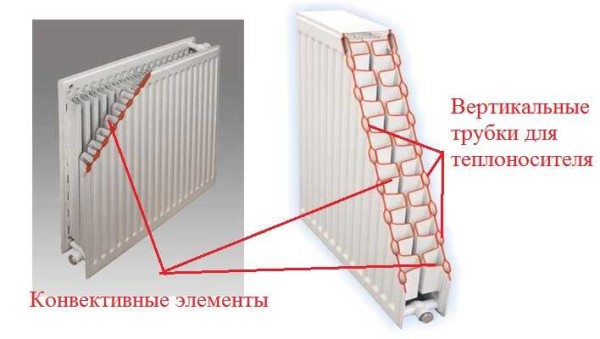
But besides the design, radiators can vary greatly in size. The length of the products varies from 400 mm to 3000 mm, and the height from 200 to 900 mm. Such a variety of sizes allows you to choose the ideal radiator model, both for standard room, and for rooms with large windows to the floor.
Also, when choosing such products, you need to pay attention to the type of connection: bottom or side. The choice is determined by the piping of the heating circuit. The lower connection somewhat reduces the efficiency of heat transfer, but it completely solves the issue of masking pipes. They can simply be hidden under the floor covering.
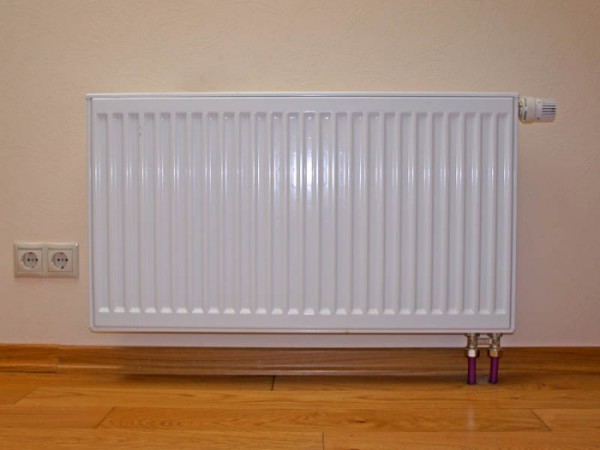
To pluses panel steel radiators include:
- light weight and thickness;
- combination of direct heat transfer and convection;
- high heat transfer coefficient;
- opportunity to choose a model different amount convectors;
- simple installation;
- affordable price (compared to a copper, bimetallic radiator);
The lack of such batteries can manifest itself in an apartment with autonomous heating. Small in size structures, contain little water. This means that the boiler will often have to turn on in order to maintain the set temperature. This can affect the economy and energy consumption. In apartments with a central heating system, this point does not matter.
The inner surface of the steel structure often does not have a special protective coating, which increases the risk of mechanical damage from abrasive substances contained in the water. If the central heating system does not differ in the purity of the coolant, then it is unlikely that under such conditions the steel panel structure will last a long time.
Video. Design features of steel panel heating radiators.
Given the thin walls of the panel structure, such units do not tolerate water hammer. Therefore, if the public service “sins” with such moments, then it is better to refuse to buy these batteries. Extraneous sounds in the batteries will help to understand the presence of such pneumatic and water hammers: crackling, murmuring, clicking. If they are constantly present in the system, then you need to contact the utility service to fix these problems.
Unlike panel construction, tubular radiators consist of separate sections in the form of pipes. By welding, they are hermetically glued together.
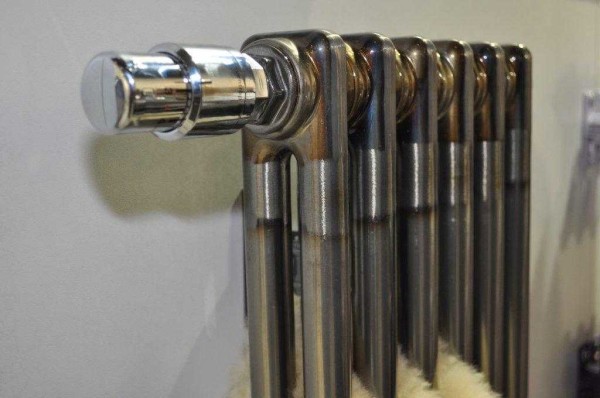
Such batteries are purchased ready-made in a certain size. Subsequently, they will not be able to “extend” or replace a section that has failed. In order for a tubular steel battery to provide the apartment with the necessary heat, it is necessary to calculate the power of the unit before buying, based on the area of \u200b\u200bthe room and the number of windows.
The continuity of the connection of individual pipes is an advantage and a disadvantage at the same time. Yes, on the one hand there is no way to increase the battery capacity in the future. But, on the other hand, the absence of connections excludes the possibility of leakage during an accident and strong water hammer. And this, in turn, significantly increases the reliability and service life of products.
Given the low operating pressure in tubular batteries (8-10 atmospheres), it is better to complete the design with a gearbox so that hydraulic and pneumatic shocks of the central heating system do not lead to an emergency.
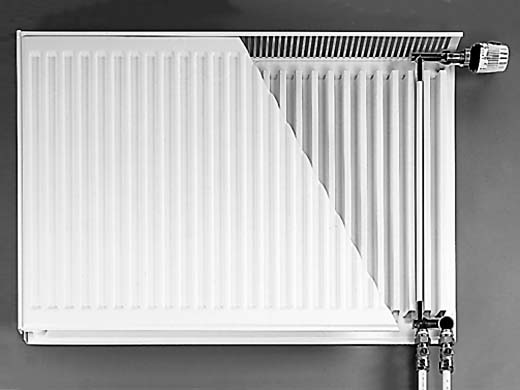
Compared to panel construction, tubular models are more resistant to corrosion and abrasive substances contained in water. It's all about a special protective coating made of polymeric materials, which is applied by manufacturers to the inside of the unit.
A wide variety of tubular batteries makes it easy to choose them for apartments with any type of layout and window size. The height varies from 200 to 600 mm, the depth from 100 to 250 mm, and the length depends on the required power.
The design can include from two to 6 pipes of different sizes.
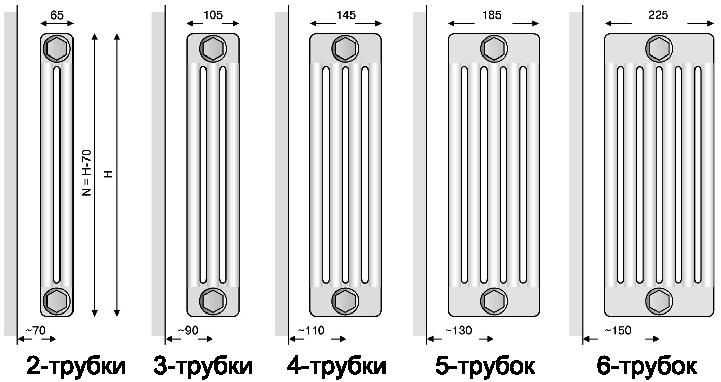
- 2-pipe from 50 mm to 65 mm;
- 3-pipe from 100 mm to 110 mm;
- 4-pipe from 135 mm to 145 mm;
- 5-pipe from 170 mm to 190 mm;
- 6-pipe from 205 mm to 225 mm.
A variety of design solutions also allow you to choose the optimal model. Floor, wall, corner, vertical and horizontal - they can even be located in the center of the room. This option not only allows you to effectively warm up the room, but also visually divides it into 2 zones.
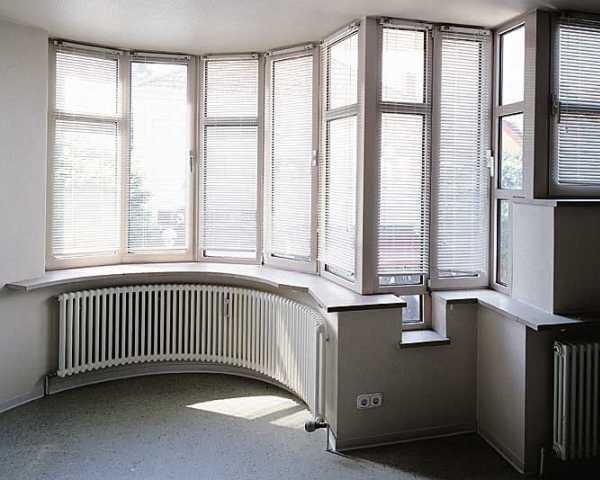
Pros:
- light weight and thickness;
- simple installation;
- corrosion resistance (compared to panel construction);
- affordable price;
- a wide variety of sizes and design solutions;
- rapid heating of the room;
- low requirements for the quality of the coolant.
Minuses:
- sensitivity to pneumatic shocks (since the elements are interconnected by welding);
- low heat dissipation.
Conclusion: for multi-storey buildings with a central heating system, experts do not recommend choosing this type of radiator.
Bimetal radiators
Today, bimetallic radiators are the most popular, as they combine all the advantages of aluminum and steel structures. They are perfect for installation in apartments with central heating and their only drawback, perhaps, can only be called a high price.
Although thanks to the optimization of production facilities, a well-thought-out logistics scheme and cooperation only with trusted suppliers of raw materials, the STOUT brand manages to maintain affordable prices for all bimetal radiators.
Heating appliances are designed specifically for our market and are successfully operated in any region of Russia. Radiators withstand pressure up to 100 atmospheres, work effectively with coolant temperatures up to 135 ° C, have a 10-year warranty from the manufacturer. Available number of sections: from 4 to 14, so you can easily select the right equipment.
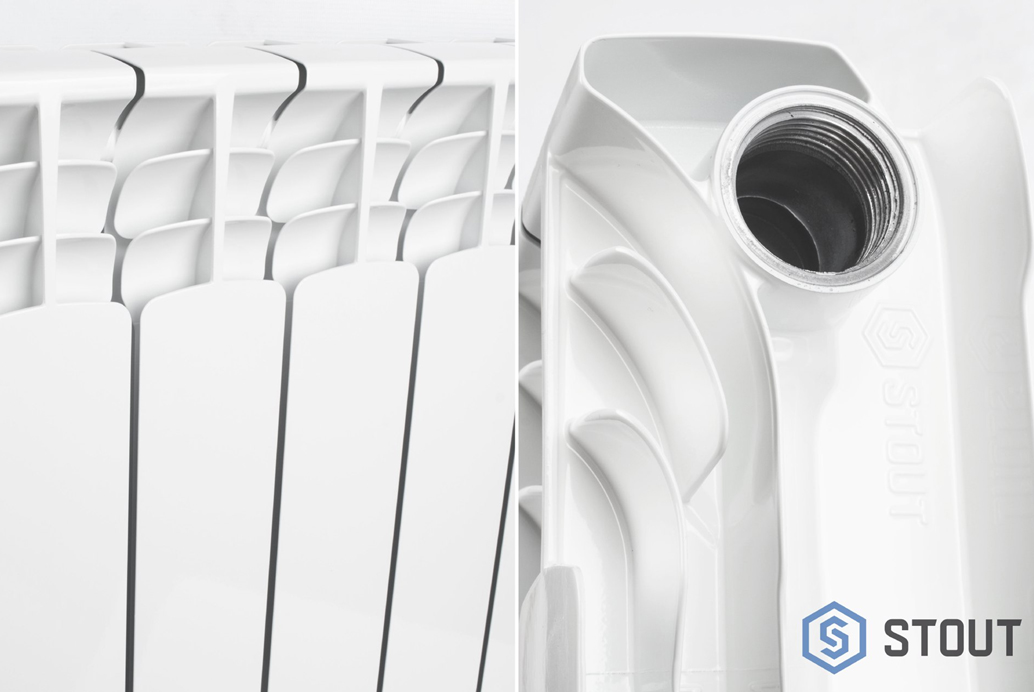
What is the design feature and what material are these radiators made of?
For the production of bimetallic radiators, manufacturers use 2 types of metal: steel and aluminum. To improve the technical properties, various silicon compounds can also be added to the composition, which increase the service life and wear resistance of the batteries.
If you look inside the bimetallic radiator, we will see a two-piece design.
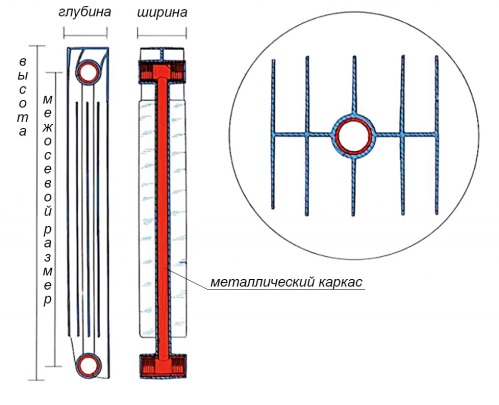
Steel core through which the coolant circulates. The task of this core is to accumulate heat energy and transfer it to the second part, made of aluminum. It is the aluminum heat exchanger that transfers heat to the room. In addition, the aluminum casing does not come into direct contact with hot water. This task is taken on by a high-quality steel alloy. The outer part is covered with enamel paint with a protective coating, which gives the structure a stylish modern look.
The combination of the strength of steel and the high heat dissipation of aluminum allows manufacturers to produce highly efficient devices that quickly heat up a room, are not afraid of pressure drops in the system, and are resistant to corrosion.
The steel core is able to withstand a working pressure of 35-40 atmospheres. At the factory, bimetallic radiators are tested for strength, creating a pressure of 45-50 atmospheres. So, when purchasing these batteries for apartments with an unstable heating system, you don’t have to worry about the failure of the unit or creating an emergency.
In some models of bimetallic radiators, the core is made not of steel, but of copper. This is a real salvation for autonomous systems, in the coolant of which antifreeze is added. Usually this substance destroys steel products very quickly.
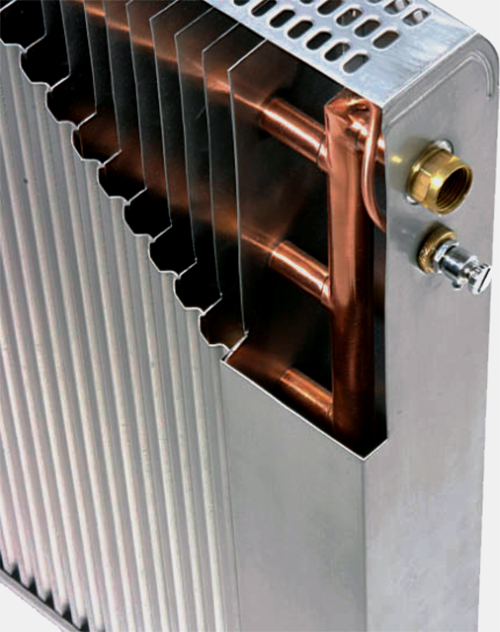
The outer panel of the radiator is a ribbed design, which improves the efficiency of heat transfer. The smooth surface with a two-layer coating provides easy maintenance, dust does not settle on them. Given the low weight of the structure, installation will not take much effort and time.
The internal part of the structure is covered with a special protective layer using polymers, which protects the radiator from the mechanical impact of abrasive substances contained in water.
On sale today standard sizes bimetallic radiators with a center distance of 200, 300, 350, 500 and 800 mm. When calculating the required number of sections, be sure to focus on this parameter.
Bimetallic batteries are of two types: sectional and monolithic. Monolithic structures have a much higher price, but their technical features are much higher. The absence of joints and joints prevents leakage and breakage of products, increasing their reliability. The only caveat is that products with a solid core cannot be supplemented or reduced.
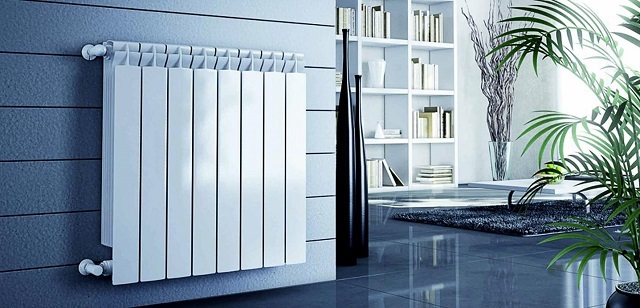
This video will help you choose the right bimetallic radiator for your apartment.
Video. Tips for choosing a bimetallic radiator for an apartment.
Pros:
- High pressure resistant.
- High heat transfer coefficient.
- Increased resistance to water hammer.
- Low requirements for the quality of the coolant.
- Variety of design solutions.
- Light weight.
- Ease of installation.
- Stylish appearance.
- Long service life (up to 50 years).
- Ease of installation.
As mentioned above, the only downside bimetallic radiators, their high price can be called, which fully pays off with a long service life, reliability and resistance to water hammer.
In apartments with an individual heating system, where the pressure does not exceed 8-10 atmospheres, and working temperature manually regulated, buying bimetallic radiators may seem like overkill. But for apartments with central heating in multi-storey buildings - this is an excellent choice.
The only thing to consider before buying is their similarity with aluminum radiators. Given that the outer casing in bimetal units is made of aluminum, you will never be able to tell the difference between the two designs without looking inside. Therefore, buy such products only in specialized stores and, of course, ask to read the technical documentation of the products before buying it.
Copper radiators
This type of radiator can hardly be called popular because of its high price. But in terms of their technical characteristics, they can seriously compete with aluminum and bimetallic batteries. Such products are made from high-quality copper, without the addition of any impurities, which significantly increases their strength, flexibility and wear resistance.
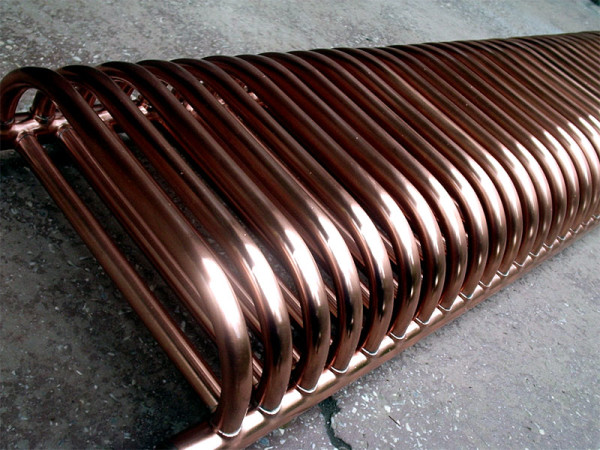
Copper batteries have a number of undeniable advantages:
- High efficiency (5 times higher than cast iron radiators). They heat up the room very quickly and at the same time spend minimal energy.
- Antiseptic. Copper prevents the formation and reproduction of microorganisms that are harmful to human health.
- High strength. Such units are great for apartments with a central heating system, they are not afraid of water hammer and work with a pressure of 20-25 atmospheres. The purchase of these products will be an excellent solution for an apartment in a multi-storey building.
- Possibility of use with high-temperature heat carriers. This makes copper radiators an excellent solution for climate zones with harsh winters. Copper radiator can heat up to 140 0 С.
- For apartments with independent heating, where not water, but antifreeze acts as a coolant, a copper radiator is the only right solution.
- Radiators coated with copper do not need additional processing and painting, which significantly affects heat transfer.
- High corrosion resistance.
- Long service life. According to this parameter, radiators can only be compared with cast iron products and bimetallic batteries.
- Stylish design. The variety of sizes and styles of copper radiators allows you to harmoniously fit them into a modern interior.
- High economy. This criterion will be especially important when choosing a radiator for an apartment with an individual heating system.
Minuses:
Of the disadvantages of copper radiators, perhaps, only their high price and high requirements for the choice of pipe materials and the quality of the coolant can be distinguished. Such units can only be connected to a copper pipeline. Otherwise, copper will enter into a chemical reaction with another metal, which will lead to corrosion and destruction of the product. Connecting elements (fittings) must also be made of copper or brass.
By what criteria is it better to choose radiators for an apartment?
Not only the technical characteristics and operating conditions of the central heating system determine the choice of batteries. There are many criteria by which it is necessary to choose radiators.
- Operating pressure. The operating pressure must be indicated in the passport of each product. Pay attention to this factor. It must exceed (at least 1.5 times) the pressure in the heating system. Taking into account the operational features of domestic utilities, it is the differences in test and operating pressure that cause the failure of modern radiators.
In five-story houses of the old layout, the average pressure in the system is usually 6-8 atmospheres. But in multi-story houses modern planning is most often supplied with a coolant under a pressure of 12-15 atmospheres.
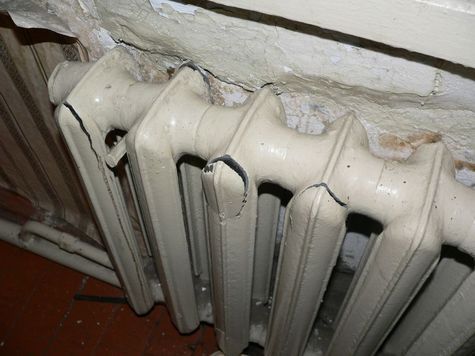

- Lifetime. This factor again depends on the working conditions and on the technical features of the utility service. Replacing batteries in an apartment is not the cheapest event, so when purchasing a new set of radiators, make sure that they serve you for at least 20-25 years.
- Ease of installation. This criterion is only important if you will install the batteries yourself. You cannot install a heavy cast iron structure alone, but even a beginner can easily install light panel radiators.
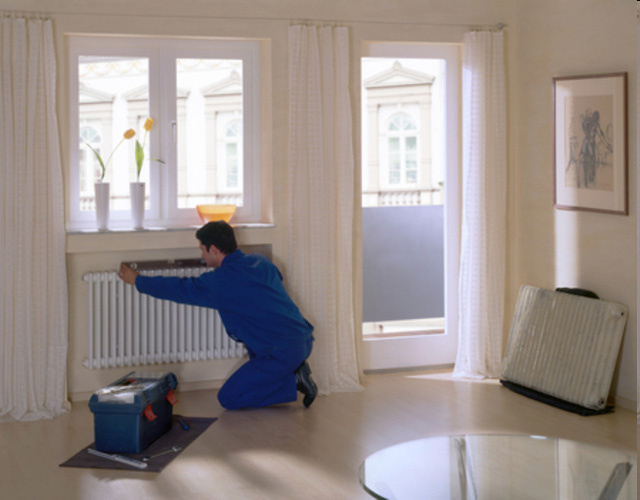
Summing up, we can do the following brief description radiators according to all their technical properties:
Brief description of radiators
| Type of radiator | Limit t °C | Operating pressure | Lifetime | Power 1 section |
|---|---|---|---|---|
| Cast iron | up to +150 °C | up to 15 atm | up to 50 years | 80-160W |
| Aluminum | up to 110 °C | 10-15 atm | 10-15 years old | 82-212W |
| Steel panel | up to 110 °C | 8-10 atm | 12-15 years old | 90-212W |
| Steel tubular | up to 120 °C | 15-20 atm | 15-20 years old | 90-212W |
| Bimetallic | 100°C | 30-35 atm | up to 50 years | 170-190W |
| Copper | up to 140 °C | 20-25 atm | up to 50 years | 180-200W |
So, when choosing radiators for an apartment, always consider the features of the heating system. Don't skimp on these products. A low price can not only cause an emergency in the house, but is also unlikely to help create a comfortable microclimate in the house.
At the end of this article, we suggest that you familiarize yourself in detail with the various types of radiators presented today on the market using video instructions:
Video. Instructions for choosing heating radiators for an apartment
Copying the article is allowed, but please put a direct link to the site. Thank you.
One of the pressing issues that concerns all people without exception is the issue of providing heat to the place where we live. After all, no interior, even the most sophisticated, can create comfort and coziness for us if the issue of heating is not resolved.
Perhaps, today there is not a single dwelling in which it is impossible to install radiators, whether it be houses with a central heating system, apartments, or a private mansion. This is where the question arises: which heating radiator to choose?
There are a wide variety of models on the market today. Deciding on your own which heating battery to buy, by what criteria to select it, how to choose a radiator that would serve for more than one year, and the heat transfer of the battery was high, is sometimes not easy.
In this article, we have tried to answer the following questions as clearly as possible:
- What are the pros and cons of radiators? various kinds;
- which batteries have better heat dissipation (greatest heat dissipation);
- Which heating radiators are the most reliable.
We are sure that after reading this article you will be able to decide on your own the answer to the question of which heating radiator is the best for your house, apartment or cottage. And if you can't, ask our experts! We will definitely help you.
Criteria for choosing a heating radiator
Design - contrary to logic, often the first thing that draws attention is the appearance of the radiator. One can, of course, find an explanation for this approach: why then change the old, clumsy, huge cast-iron batteries?
Price is the deciding factor for many. Why pay more when you can save.
Heat dissipation is the most important characteristic of a radiator for specialists. After all, it is heat transfer that affects the efficiency of heating a room. Therefore, it is good if this indicator is as high as possible. An approximate guideline is 100-150 W of heat transfer per 1 sq.m. heated room.
Reliability and durability - there are unpleasant features in our centralized heating systems - pressure instability and severe contamination of the heating water. This can lead to so-called water hammer and corrosion. Therefore, it is advisable to choose a radiator model with an anti-corrosion coating. Please note that the pressure in the heating system of high-rise buildings is 9-10 atmospheres, and in individual boiler rooms - up to 6 atmospheres. So the reliability and durability of the heater is determined, first of all, by this indicator.
Size - affects the overall external space. The size depends on the area of the heated room, the purpose of the radiator: for home, office, non-residential premises.
Mass - the radiator must not only be bought, but also transported to its destination, mounted and installed.
Aluminum heating radiators: characteristics, pros and cons
An aluminum radiator is a heating device made of aluminum alloy. special purpose with high heat dissipation.
To date, aluminum radiators are the most popular among heating devices. Although they appeared quite recently, in the 80s of the last century, in modern world recognized as the most efficient for space heating.
So which aluminum radiator should you choose? Let's move on to the pros and cons of aluminum radiators!
Advantages of aluminum batteries:
- small size;
- ease;
- high working pressure;
- low price;
- good heat dissipation due to the presence of a large number ribs, big square which contributes to good heating.
Disadvantages of aluminum radiators:
- susceptibility to corrosion.
Corrosion is especially accelerated if there is a contact between two dissimilar metals or stray currents occur in the heating network. The same can happen if the integrity of the oxide film with which they are coated is violated.
As you can see, there are not many shortcomings.
We figured out the pros and cons of aluminum radiators, but you should know that they are solid and sectional:
- Solid aluminum radiators are made of profiles connected by welding. Since they do not have intersectional gaskets, they are strong, reliable and durable. But due to the non-separability of their design, such devices cannot be increased during operation;
- Sectional aluminum radiators consist of interconnected sections. This makes it possible to build a radiator or replace a damaged section. However, the presence of interconnects can affect their reliability and durability.
Of course, like any device, heating radiators have pros and cons, but if you put them on the scales, there are much more positive qualities. By taking all the necessary precautions when handling radiators, they will remain yours for many years. indispensable assistants in creating warmth and comfort in the house.
Information about aluminum radiators will not be complete without getting acquainted with the manufacturers.
The best manufacturers of aluminum heating radiators are European, when compared with Chinese ones. One of the most well-established brands are Italian radiators Global. In Russia, under the license of this company, an exact copy of such devices is produced - Rifar. Of course, the prices for radiators of this brand are one and a half or even two times higher than for radiators whose manufacturers are located in China.
Among the leaders in the manufacture of radiators are the Italian brands Sira, Ferroli, the Chinese Scola, the Konner brand (manufacturing country China with Russian participation).
On our website you can always buy high-quality and inexpensive aluminum heating radiators.
Cast iron heating radiators: characteristics, pros and cons
A cast iron radiator is the cheapest and most well-known version of heating systems. Despite the variety of heating equipment, cast iron heat exchangers have been and remain in demand for more than a century. If earlier, when determining the pros and cons of cast-iron radiators, their unremarkable, simple form immediately caught the eye, now we can talk about a variety of decorated options that have a beautiful and stylish appearance.
The disadvantages, first of all, include a rather old technology, thermal inertia and insufficiently fast heating of the room in which they are installed. Another disadvantage is their relatively large weight.
But if you take a closer look at these shortcomings, you will find that they are also an advantage of the equipment. Take, for example, inertia. Thanks to it, temperature fluctuations in the room are smoothed out after the heating system is turned off, so modern cast-iron radiators are able to retain heat for a very long time. Also, the duration of their service life is not comparable with any other types of products.
If we talk about the main varieties of this type of product, two types of them should be distinguished - sectional and tubular
- More popular are non-separable tubular cast-iron batteries. Their heat transfer directly depends on the size of the sections and their number. Usually there are seven such sections, and they are connected to a battery. To increase heat transfer, ribs are placed in the sections;
- Sectional batteries also remain quite popular, especially since their design has improved significantly and they can fit perfectly into any interior.
The following information will help answer the question of how to choose a cast-iron radiator:
- Firstly, if you have natural water circulation in your room, the best option for you - cast iron;
- Secondly, if you want the heat to be retained for a long time after the heating system is turned off, cast iron models have no equal;
- Thirdly, if your heating system does not run on gas, but on some other type of fuel, it is advisable to give preference to time-tested cast iron appliances.
Today, the heating equipment market offers a wide range of cast iron radiators from various manufacturers. What to choose?
The best manufacturers of cast iron radiators
- German company Guratec, one of the leading companies in Europe;
- Consumers are constantly interested in cast-iron radiators of the Konner brand, manufactured by Chinese manufacturers with the participation of Russia;
- Among domestic manufacturers it is possible to allocate the company SANTEKHLIT;
- Lugansk Foundry and Mechanical Plant, Ukraine, also produces high quality cast iron radiators.
You can buy a cast-iron radiator on our website.
Bimetallic heating radiators: characteristics, pros and cons
A bimetallic radiator is a heating device that is an alloy of aluminum and steel.
The basis of the design of such devices is a steel "skeleton", welded from vertically and horizontally arranged pipes. The horizontal pipes are called the lower and upper manifolds. Then this blank is inserted into a special mold and filled with molten aluminum. This is the technology that allows you to get a section that looks very similar to aluminum. The heat transfer in this case is very high.
It is worth highlighting such types for installation in residential premises: full bimetallic and non-full bimetallic.
You can buy a bimetallic radiator on our website.
Steel heating radiators: characteristics, pros and cons
A steel radiator is an excellent combination of three factors: thermal power, appearance and price, which makes these devices quite popular. In addition, they are suitable for any materials used in the installation of the heating system.
Today the market provides the widest range of steel models. However, it should be borne in mind that each of them has its own scope, as well as certain operational properties and technical characteristics. Therefore, before choosing one or another model, you need to know and take into account the features that your heating system has so that the reliability of steel batteries does not raise doubts in you.
Steel radiators are tubular and panel
1. The working pressure for which panel radiators are designed is 8-10 atmospheres, so they are preferred to be used in a house or apartment with individual heating. They have such advantages as an interesting original appearance, which allows them to fit into a room with any interior. They have a high heat dissipation, they are very easy to install. They can be connected to both two-pipe and one-pipe heating systems. They have an energy-saving mode that can be adjusted. Disadvantages are, first of all, poor resistance to hydraulic shocks, i.e. pressure drops in the heating system and susceptibility to corrosion. Therefore, the reliability of steel radiators of this type leaves much to be desired.
2. New types of batteries include tubular steel radiators. Their feature is the presence of an inlet and outlet manifold, which is connected by a number of tubes. This is a more powerful battery than a panel battery. It withstands a pressure of 12 atmospheres, so it can be used in apartment buildings; does not corrode if it is in a closed system. Along with the advantages, they have tubular steel radiators and disadvantages, which are a fairly high price and susceptibility to corrosion if used in an open system.
The leader in the production and sale of steel radiators is Italy (trademark Delonghi). Also popular are brands such as Elba, Grandini, Warme, Kraft (Turkey), Imas (Italy), Kermi (Germany), Korado (Czech Republic), Maxiterm, Term_ya (Ukraine), Purmo (Finland), Vogel & Noot (Austria).
You can buy a steel radiator on our website.
Comparison table. Pros and cons of the main types of heating radiators
pros |
Minuses |
|
Aluminum |
· High working pressure; Greater heat dissipation · Lack of thermal inertia; · Easy to install; · Light weight; · Good design. |
· Negative effect of coolant alkalinity; · Susceptibility to corrosion; · Emission of hydrogen during operation; · High price. |
|
Cast iron |
· Low price; · Resistance to corrosion. |
· High thermal inertia; Lack of resistance to water hammer; Difficulty of installation External unattractiveness; Large weight; Large dimensions; surface roughness. |
Bimetallic |
Greater heat dissipation · High working pressure; · Great design; · Lack of influence of a chemical composition of the heat carrier; Small amount of water · Easy assembly. |
· High price; · Low heat transfer in comparison with aluminum radiators. |
|
Steel panel |
· High level heat transfer; · Low thermal inertia; · Possibility of installation in children's and medical institutions; · Attractive appearance; · Easy assembly, installation; · Availability of prices. |
· Resistance to water hammer; · Susceptibility to corrosion in an open system. |
|
Steel tubular |
· Originality of appearance; · Low inertia; · Easy installation. |
Lack of resistance to corrosion in an open system; · High price. |
No matter what high-quality batteries are in the apartment, sooner or later the moment comes when they have to be replaced with new devices. And immediately the problem is - which heating radiators are better to choose for an apartment? Another case when there is a desire to install new batteries is if the apartment has long had old cast-iron "accordions" that do not want to fit into the interior created by the owners.
The modern market offers a wide range of radiator models made from various materials and have a very aesthetic appearance. Comparing the design of modern appliances with rough cast-iron batteries or inefficient and low-quality convectors that were previously installed in apartments, of course, I would like to see such novelties in my possessions.
Criteria for choosing radiators
It is necessary to approach the choice of modern radiators with all responsibility, since not all of their varieties are suitable for installation, for example, in a central heating system. Some types have characteristics that are designed for a clean coolant and a certain maximum load, so they simply will not be able to withstand water hammer, which, alas, is not uncommon in our utility networks. Other radiators, on the contrary, in an autonomous heating system will not show all their potential.
In addition to the selection of radiators according to performance indicators, it is necessary to correctly calculate the number of sections in the batteries for each individual room, otherwise their efficiency will be very low, and the apartment will not be comfortable enough.
So, the effect of installing new heating devices will be expectedly high, given all their operational nuances and following all the recommended technological installation rules.
To date, several various types radiators, differing in the material of manufacture and design:
- Cast iron batteries, both old models and improved, with an elegant modern or retro design.
- Steel radiators - tubular and panel.
- Bimetal heaters made of two types of metal.
- Aluminum of various quality levels.
When choosing batteries for installation in an apartment, the following criteria must be considered:
- The maximum pressure in the central heating system in the local heating network, and the possible limit for which the vending radiators are designed..
- The maximum temperature and features of the composition of the coolant in the system, as well as the endurance of radiators to these effects.
- Material for the manufacture of devices and its main physical characteristics.
- Battery design.
- Required radiator power - based on this parameter, the number and size of sections required for efficient heating premises. These calculations are based on recommendations building codes and rules, and can be carried out in various ways which will be discussed later in the article.
To begin with, you can give a small table, which, although briefly, but quite informatively characterizes the main types of heating radiators. Well, then consider the main types in more detail.
| Types of radiators | Pressure limits: working (Rb), test pressure testing (Op), destruction (Rz), bar | Limitation chemical composition coolant by pH (hydrogen indicator) | Corrosive action: oxygen (Ok), stray currents (Bt), electrolytic pairs (Ep) | Section power at h=500 mm; t=70°С, W | Warranty, years | ||||
|---|---|---|---|---|---|---|---|---|---|
| Rb | Op | Rz | OK | Bt | Ep | ||||
| tubular or panel steel | 6÷10 | 15 | 18:25 | 6.5÷9 | Yes | Yes | weak | 85 | 1 |
| cast iron type MS÷140 | 10÷12 | 12÷15 | 20÷25 | 6.5÷9 | No | No | No | 160 | 10 |
| aluminum | 10÷15 | 15:30 | 30÷50 | 7÷8 | No | Yes | Yes | 175÷199 | 3÷10 |
| bimetallic | 35 | 50 | 75 | 6.5÷9 | Yes | Yes | weak | 199 | 3÷10 |
| anodized aluminum | 15÷20 | 25÷75 | 100 | 6.5÷9 | No | No | No | 216,3 | 30 |
Types of heating batteries and their main characteristics
Cast iron radiators
Cast iron radiators are "long-lived", but do not lose their relevance today, especially since they acquire an elegant appearance and improved performance. Batteries of domestic and foreign production are on sale, and there are certain differences between them - about them a little later.
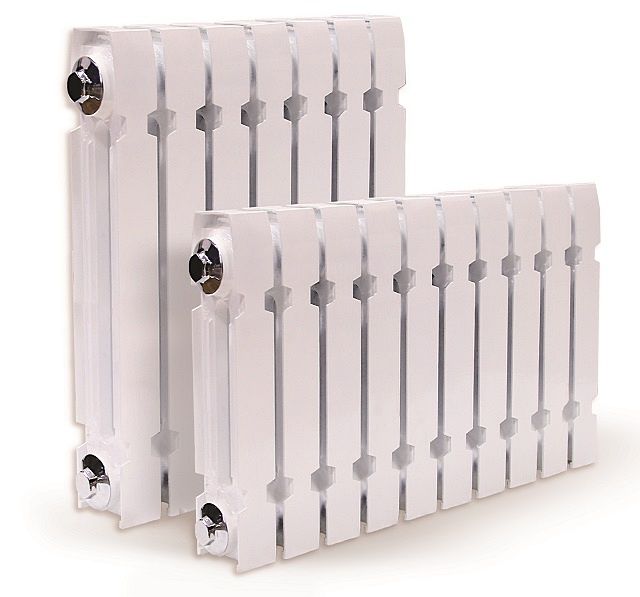
- Batteries made of this material have not lost their demand, despite the fact that other, more modern heating devices have appeared, primarily due to the technical characteristics of cast iron. It is not subject to corrosion, radiators are not afraid of water hammer, as they have fairly thick walls. Another advantage of cast iron over other materials from which radiators are made today is its high heat capacity, that is, the ability to long time keep the temperature even when the external heating is turned off.
- It is also positive that cast-iron batteries will function perfectly not only in an autonomous system with a high-quality coolant and controlled pressure, but also in a system central heating. True, it is worth immediately making a reservation about that. That it is undesirable to install them in autonomous systems that work with electric boilers - operation can turn out to be too expensive in terms of high power consumption.
- Cast iron radiators may well be installed in an autonomous open-type heating system, in which the coolant is inevitably saturated with oxygen. For cast iron, this is not scary - the material is not subject to oxygen corrosion.
- The thick walls of cast iron heaters not only keep the temperature of the coolant longer, but also increase the resistance of the batteries to abrasive wear.
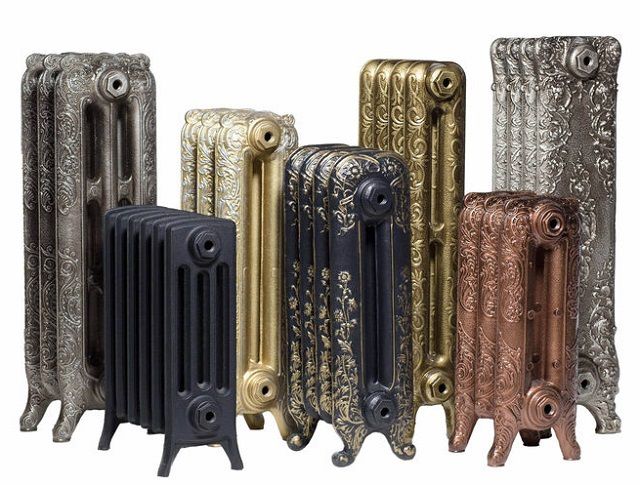
- If the old batteries had one standard size range, and for the proper heating of the room it was necessary to select a radiator exclusively by varying the number of sections, today devices with different power parameters are produced. This expands the possibilities of a comprehensive selection of the right radiators, both in terms of the required power and the design of the premises.
- In order to install old cast-iron batteries, it was necessary to drive brackets into the wall, which means damaging its finish. Modern batteries are produced both in a hinged version and in a floor version, with reliable legs. The latter are simply installed on the floor near the walls, and connected to the heating circuits.
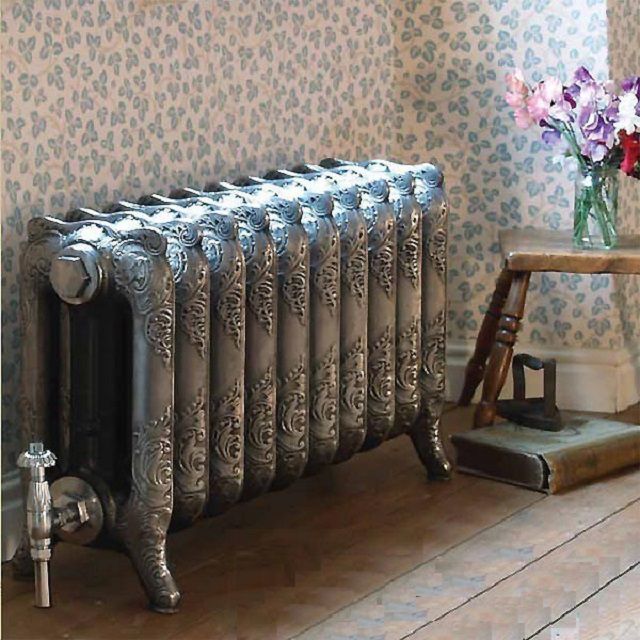
- Many modern models of cast iron radiators do not have to be periodically painted, as was the case with older battery options. They go on sale ready for installation, and already have a treated and painted surface, which does not need to be refreshed with a layer of paint annually. To care for these devices, you only need a damp soft cloth, which is brushed off or wiped off the dust. It can also be seen that absolutely smooth surfaces modern batteries are fundamentally different from the rough sections of the old model, so they practically do not collect dust.
- Some cast iron models of batteries are produced in very original styles. design decoration, which allows you to fit them into any interior, even modern, even executed under the "retro". It is possible to choose heating devices in such a way that they will also become a decorative element of the design of the room, complementing and transforming it.
The main disadvantage of all radiators made of cast iron is their heavy weight. If you plan to hang them on brackets, the latter must be securely fixed in the wall - and not every partition is even able to withstand such a load. In addition, to lift and hang such a battery, you will definitely need an assistant.
Cast iron radiators of domestic and foreign manufacturers
On the Russian market, you can find both domestic and imported cast-iron radiators. European countries — Germany, Italy, the Czech Republic, Spain and others — present their products in a fairly large assortment. These products differ significantly from Russian ones in some characteristics:
- Unlike traditional domestic MS-140 or MS-90, foreign products have smoother, well-finished outer surfaces, and the original retro versions are decorated with molding in the form of floral relief ornaments.
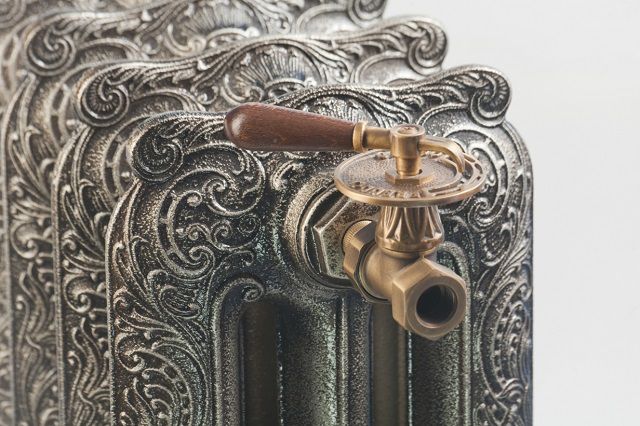
- Imported products have a higher thermal power with small dimensions. So, for example, with the same heat transfer, the volume of filling the domestic battery section with a coolant is 1.3 liters, and the Czech production is only 0.8 liters. Therefore, this option will be more compact and accurate.
- Foreign products have internal perfectly smooth cavities, which contributes to the normal circulation of the coolant, without high hydraulic resistance, and prevents the formation of deposits of dirt and scale on the walls of the channels.
- Domestic batteries go on sale with primed surfaces and require painting, while imported ones are immediately ready for installation.
![]()
- The "minus" of foreign products is their very high cost, several times higher than the price of Russian-made batteries.
In fairness, it must be said that the production of more modern cast-iron batteries is gradually being established in our country. In addition, excellent cast-iron radiators of European quality are also produced in neighboring Belarus at the Minsk Heating Equipment Plant.
Conclusion: for the conditions of an apartment, cast-iron radiators are quite applicable, especially when connected to a central heating system, of course, taking into account their characteristic shortcomings.
Steel radiators
Modern steel radiators differ both in their construction and design. They are usually made in the form of panels or pipes arranged together, which is why such heaters are called tubular or panel. To understand their design and characteristics, you need to consider each of the types of batteries separately.
Panel steel radiators
Panel radiators consist of two steel sheets, which are attached desired shape stamping method. Then the blanks are welded into a hollow panel and, if necessary, equipped with special convector elements - in order to create a vertical directional movement of heated air, thereby forming a kind of thermal curtain from the cold coming from the window.
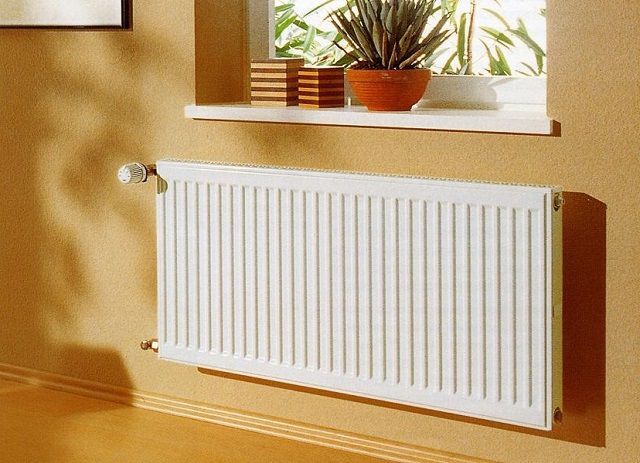
The coloring of such a battery occurs after the assembly of all elements into a common structure. The paint is applied using a special technology that ensures the strength and durability of the coating.
In order for steel batteries to last as long as possible, the protective paint layer must be applied evenly. Therefore, when purchasing this type of device, special attention should be paid to the coating, since steel sheets can be susceptible to corrosion in damaged areas that are not protected by paint.
Panel batteries are designed for a coolant having a temperature of up to 85 ÷ 95 degrees, as well as for a standard pressure created in a centralized heating system.
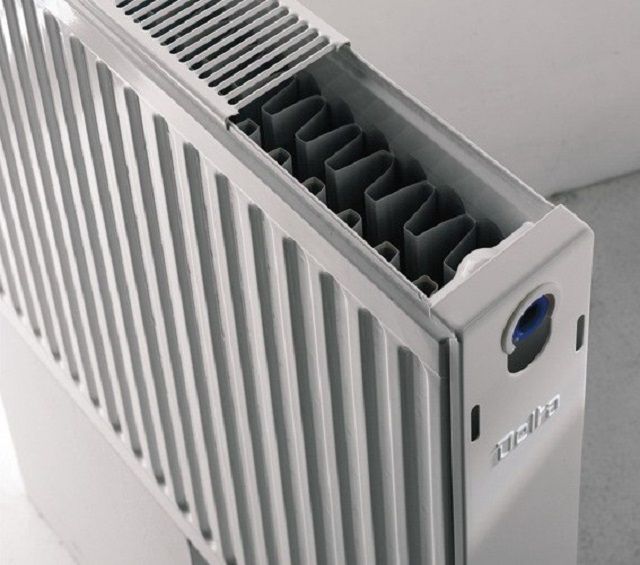
The number of panels and heat exchange convector "accordions" can be different
This type of heating device usually has its own classification, which is based on the number of panels and convection heat exchangers in the finished assembly. An example is shown in the table:
Panel radiators can vary quite a lot not only in the number of panels, that is, in the depth of the structure, but also in other dimensions. Their length can be from 400 to 3000 mm, and the height usually varies from 200 to 900 mm.
In addition, panel batteries are produced with a bottom or side connection. The choice for this parameter is made depending on how the piping of the heating circuit is located.
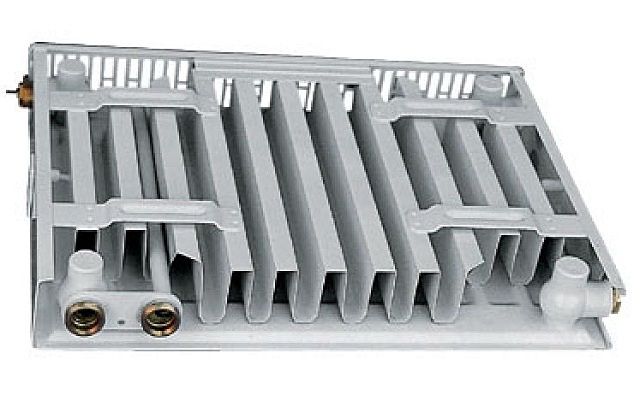
Panel heating radiators have their advantages and disadvantages, which you should definitely familiarize yourself with before making a decision to purchase.
To positive aspects panel radiators include the following:
- Relative ease of installation of devices in the heating circuit. The radiator has a one-piece construction, and it does not need to be assembled from separate sections.
- Panel radiators tend to warm up quickly. A sufficiently large area of the panel itself and the fins of heat exchangers-convectors contributes to efficient heat transfer, so the room warms up quickly enough.
- The compact size and aesthetic appearance make it possible to fit such a radiator into almost any interior.
- To fill an autonomous system with panel radiators installed in it, a fairly small amount of coolant is required.
Panel radiators also have their own significant disadvantages, which include the following:
- They are reliable for normal pressure in the central heating system, but are not designed for powerful water hammer, which often occurs when the system is filled with coolant before the start of the heating season. Panels may simply not withstand such a test. Therefore, if they are chosen for installation in an apartment, it is necessary to use a special device to protect against excessive intra-system pressure - a reducer that will smooth out the load on the panels by taking the blow.
- The inner surfaces of the panel often do not have an anti-corrosion coating, although they are in direct contact with the coolant, and the durability of their use will depend on its quality. As you know, in the central heating system, the coolant very often does not differ high quality, and may contain highly active impurities that contribute to metal corrosion. Therefore, as a rule, a panel type of a radiator cannot be used in such conditions for a long time, since steel unprotected surfaces are not resistant to aggressive environments.
Based on the above considerations, conclusion that the installation of panel steel radiators in apartment conditions with a central heating system is undesirable.
Tubular steel batteries
Unlike panel radiators, tubular ones consist of several sections, but "tightly" fastened together by welding. Therefore, they also do not need to be assembled, since they are purchased ready-made, representing a complete structure from a certain number of sections. Therefore, in order for heating to be efficient, it is necessary to calculate the required total power required for a specific area before purchasing such radiators, and from these considerations select the optimal model.
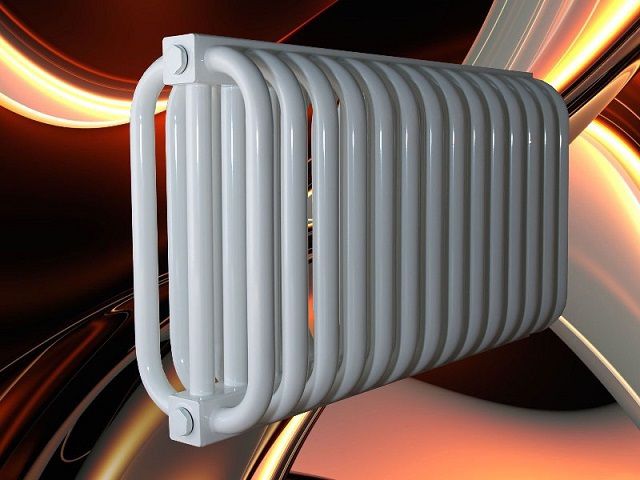
Batteries of this type are designed for an internal pressure of 8 ÷ 10 atmospheres, so it would be useful to install a reducer, since water hammer when filling the central system with a coolant can lead to emergency situations.
Steel radiators have a wall thickness of only 1 ÷ 1.5 mm, so the coolant quickly heats them up, and the metal begins to transfer heat into the room. However, it should be noted that thin walls are weak side such batteries, as they are easily susceptible to mechanical damage.
Tubular structures are more resistant to the aggressive environment of low-quality coolant than panel structures, since they usually have an internal protective coating of polymeric materials. Therefore, they are less exposed to corrosive influences and, accordingly, with other normal parameters of the system, they can last longer.
Tubular radiators can have a variety of, sometimes even "unexpected" dimensions. So, their height is from 200 to 2500 mm, depth - from 100 to 250 mm, and the width can vary widely depending on the need for total thermal power.
Tubular radiators are produced in a wide variety of design solutions, can be wall and floor. Moreover, they are installed both near the wall or window, and even in the middle of the room. For installation in the center of the room, radiators are used that have a height equal to the height of the ceiling, taking into account the supporting legs. This option is used when the room needs not only to be heated, but also divided into separate zones.
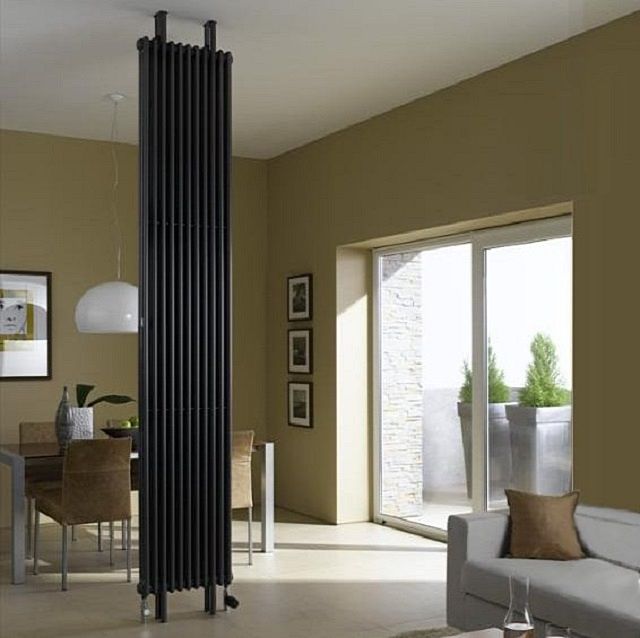
- Some battery designs are equipped with wooden panels mounted on top, and, in fact, are a bench designed for different needs, depending on the location of the heater. For example, if it is installed in the hallway, it can be used as a shoe stool, as it will be convenient to sit on it. In the evening on wooden surface can be installed to dry shoes.
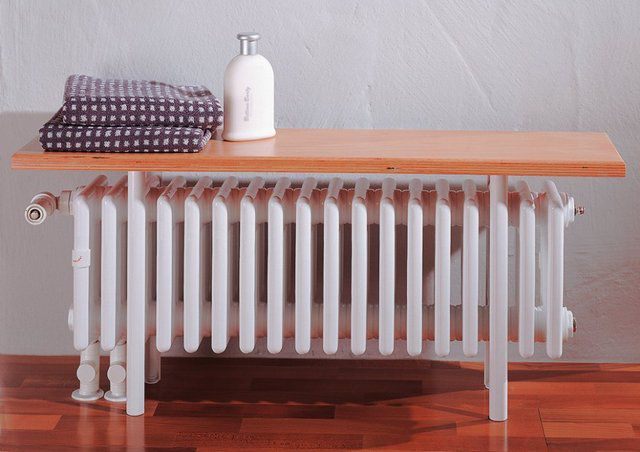
Since tubular batteries are produced in different color scheme and in a variety of, even sometimes unexpected design delights, they can be matched to any interior design.
The disadvantages of batteries with a tubular design include only two main points, but quite serious, negatively affecting the efficiency and safety of the apartment heating system:
- Sufficiently low heat transfer, leading to an increase in energy costs if the batteries are installed in an autonomous heating system. The design heats up quickly, but it also tends to cool down quickly, so the heating boiler will work almost constantly, with short interruptions. The conclusion is that it is unprofitable to install them in the autonomous heating system of a private house.
- The elements of the radiator are connected by welding, the seams of which will become a weak point in the event of water hammer. Therefore, mounting them in an apartment circuit connected to a central heating system is also undesirable. If they are nevertheless chosen due to a suitable design, then it is necessary to install a gearbox that will take the load from a sharp pressure drop on itself.
Conclusion from what has been said : Tubular steel batteries, despite their external attractiveness, are far from perfect option. Installing such radiators in an autonomous system will lead to extra costs to energy carriers, and to the central heating system - to an increased risk of emergency situations.
Aluminum radiators
Aluminum batteries have an aesthetic appearance, but it must be said right away that, according to their technical characteristics, they are not very well suited for installation in a central heating system.
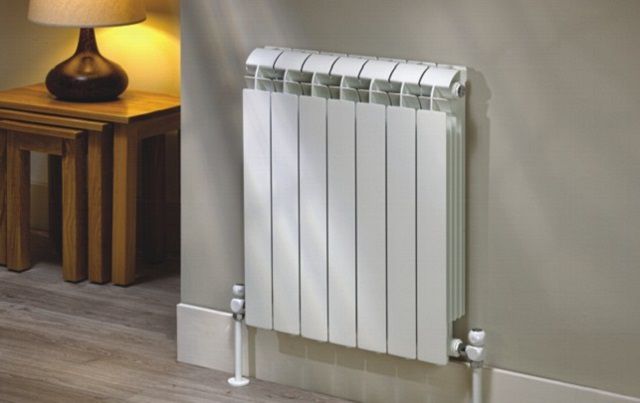
For autonomous heating systems, the best choice is high-quality aluminum radiators
Aluminum radiators are very popular among homeowners with autonomous heating due to their elegant appearance and high heat output. In an autonomous system with a stable pressure and a high-quality coolant, aluminum heaters can last from 15 to 25 years - these are the periods that manufacturers usually indicate in the technical data sheet as the minimum.
Radiators are designed for internal system pressure up to 15 atmospheres and coolant temperature of 80÷90 degrees. They have excellent power (heat dissipation), reaching up to 200 ÷ 210 W, and at the same time, the volume of each of the battery sections is only 450 ml with a weight of 1 ÷ 1.5 kg. The sections are fastened with the help of a threaded coupling.
Aluminum batteries can vary in size. So, the standard distance between the lower and upper axis of the radiator can be 500, 350 and 200 mm. If desired, you can find or order devices with a non-standard distance of 700 or more millimeters.
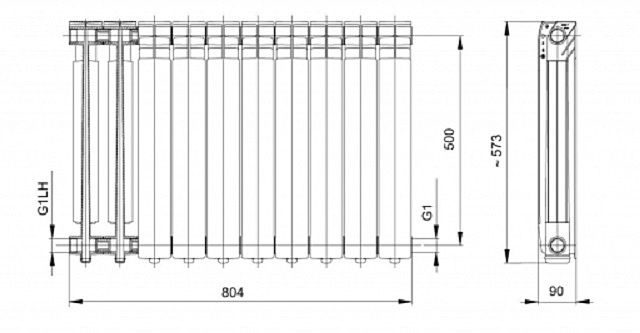
The drawing shows a 500 mm center connection with a total battery height of 573 mm.
This type of battery is made from an alloy of aluminum and silicon additives that give the metal additional strength, but in two different ways - extrusion and casting.
When using casting technology for the manufacture of parts, each section of the battery is cast separately by filling a special mold with a prepared alloy. This manufacturing technique guarantees the tightness of each section.
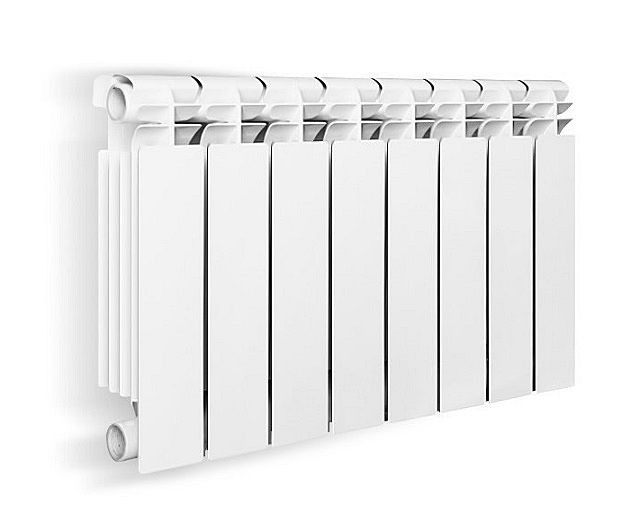
- Batteries produced by casting technology are designed for pressure in the heating system up to 16 atmospheres. During factory tests (pressure testing), the coolant is usually supplied under a higher load, which reaches up to 25 atmospheres, which indicates that the manufacturer provides consumers with an additional margin of safety for their products. Molded heatsinks come in a variety of shapes, but generally they have a smooth outer surface that allows for higher heat dissipation.
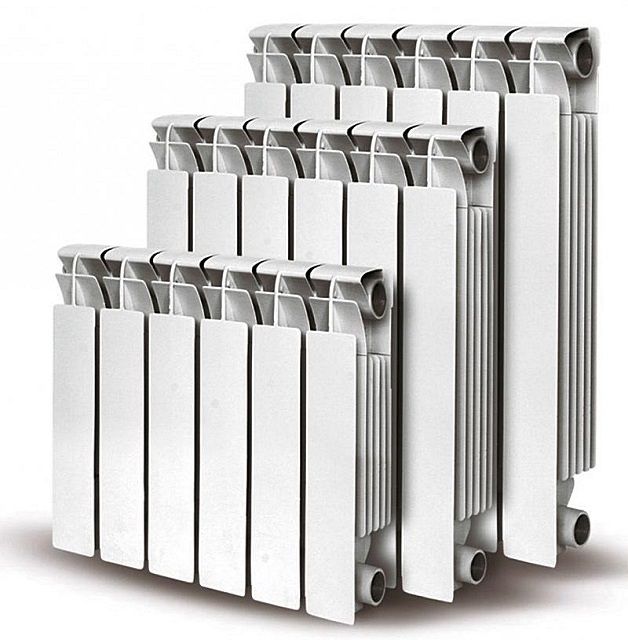
- The second, manufacturing method, according to extrusion technology, consists in forming sections by forcing the melt through special nozzles that set the configuration of the products. As a rule, the so-called secondary aluminum, a product of scrap processing, acts as a raw material here. The quality of the metal is certainly worse, since the composition of the alloy is not so balanced, the presence of impurities is not excluded. Such aluminum turns out to be more brittle, more prone to oxygen corrosion.
The finished sections are assembled into a common structure, which during operation cannot be increased by extension or reduced - a ready-assembled battery comes from the factory, which is a finished product. Such radiators also cannot be repaired - this should be taken into account when planning a purchase. Terms high pressure in the system, low-quality coolant, the likelihood of water hammer - obviously not for such radiators. True, the price of such heat-exchange devices is significantly lower than for cast ones.
- Another type of aluminum radiators is being produced, but already possessing a high degree purification of feedstock and with anodic oxidation of surfaces. They are often referred to as anodic. During the manufacture of the original alloy, aluminum changes its structure several times - this process is carried out to achieve maximum resistance of the material to any type of corrosion. Therefore, such batteries are not afraid of the aggressive environment of any coolant.
Anode radiator sections are manufactured using injection molding technology and then assembled using threaded couplings and reliable seals. Such products can, if necessary, be disassembled, for example, to remove a damaged section, or extended to obtain the required total heat output.
The internal surfaces of the batteries, made of anodized aluminum, are perfectly smooth, which contributes to the unhindered circulation of the coolant. The working pressure of such radiators is much higher than that of conventional aluminum ones, and can reach up to 20 ÷ 25 atmospheres.
Externally, anode batteries do not differ from ordinary aluminum ones, but their cost is much higher. Therefore, when purchasing this version of radiators, it is imperative to check the product passport, which is always attached to such high-quality products.
All aluminum batteries have common "pros" and "cons", which you also need to know if you decide to choose this type for installation in an apartment.
So, the advantages of aluminum radiators include the following qualities:
- High heat dissipation.
- Light weight, which greatly simplifies the stages of transportation and installation work.
- Variety of sizes to choose from.
- Aesthetic appearance that allows you to "introduce" such radiators into the interior of any style.
- Relative safety of operation. When hitting even and smooth aluminum surfaces, it is more difficult to get injured than, for example, angular cast-iron batteries - this quality is especially important if small children live in the apartment.
- Aluminum batteries are excellent "friends" with thermostatic devices - this allows you to accurately control the temperature. This quality is especially important in the event that an autonomous heating system is created in the apartment, since the devices for thermoregulation of radiators contribute to saving on energy consumption.
The negative aspects of these heating devices are the following factors:
- High risk of gas formation in the internal channels of the structure (applies to conventional, non-anodized aluminum batteries, cast or extruded).
- Possible leakage at the connection of sections without the possibility of repair - for extrusion radiators made of recycled aluminum.
- Heat concentration in the region of the fins of the device elements.
Some possible problems that arise during the operation of aluminum batteries can be bypassed. So, for example, in order to prevent gases from accumulating inside the structure, it is recommended to install a special air vent for each radiator.
General conclusion: If aluminum batteries will be installed in an apartment with an autonomous heating system, then any will do, based on the financial capabilities of the owners and taking into account all the above disadvantages. If the apartment is connected to central heating networks, it is recommended to choose only radiators made of anodized aluminum - it is more resistant to aggressive environments, high temperatures, and pressure drops in the system.
Bimetal radiators
Bimetallic radiators are currently the most popular of all types of modern batteries, second only to traditional cast iron batteries.
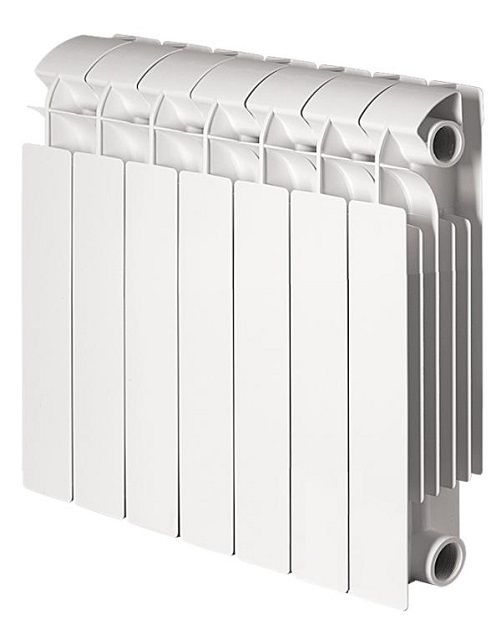
These heaters are produced according to the combined principle - they are assembled from parts made from two different materials, which, in fact, is clear from the name. So, the outer part of the battery is made of aluminum, which has maximum heat transfer, and the internal channels for the circulation of the coolant are made of high-quality steel alloy that is not subject to corrosion. Aluminum external surfaces have a protective enamel coating, which gives the radiators an aesthetic appearance.
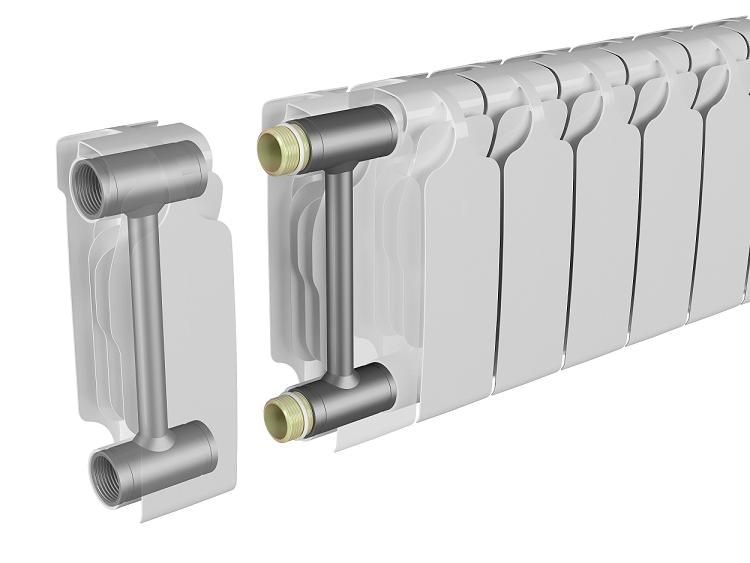
Bimetallic batteries are assembled from sections that are fastened together by a threaded coupling using reliable seals.
The reliability and durability of these radiators is explained by the fact that aluminum, which conducts heat well, does not come into contact with the coolant and serves as a kind of decorative “casing” for internal steel elements through which antifreeze or water circulates. The internal channels, made of stainless alloys, are very resistant to baric loads, thanks to which the radiators are able to withstand pressure in the system up to 35 ÷ 40 atmospheres.
The similar qualities of these batteries allow them to be fully used for central heating circuits, that is, to be installed in apartments of multi-storey buildings. They are also suitable for autonomous heating systems.
By the way, bimetallic batteries fully reveal all their advantages precisely at high pressure and temperature values typical for central heating circuits. For autonomous systems, however, such expensive devices may still seem like overkill.
With such high performance, long and warranty periods of use, bimetallic batteries are quite justifiably expensive, especially compared to steel or aluminum options. This circumstance can be called, perhaps, the only drawback, but on the other hand, such batteries can have a lot of advantages:
- Bimetallic batteries have high thermal conductivity, so they quickly heat up and give off heat to the room.
- Corrosion resistance significantly extends the period of their trouble-free operation, which can be calculated for many decades.
- Neat appearance and compact design allow you to fit radiators into any style of interior.
- This type of radiators have a hardened two-layer outer coating, so a large amount of dust does not accumulate on their surface. They are easy to care for, as it is enough to wipe them with a damp soft cloth.
- Radiators have a relatively small weight, so their installation is quite simple, and it can be done without the involvement of specialists.
It should be noted that bimetallic radiators in appearance are practically indistinguishable from aluminum ones, with a very noticeable difference in price. Therefore, you need to purchase them only in specialized stores, carefully reading the technical documentation and manufacturer's warranties.
Conclusion: Bimetallic batteries can be safely called universal. They are fully suitable for installation in an apartment with a central heating system. Nothing prevents them from being purchased for an autonomous system, but their specific advantages in such conditions may not be in demand. It may be wiser to purchase more affordable high-quality aluminum radiators.
Calculation of the number of sections or the total power of radiators
Calculation by basic formulas
As mentioned above, the calculation of the number of radiators per separate room can be done in two ways - by area or by room volume.
- Calculation by area
The calculation is thus made according to the formula:
N = S × 100 / Pc,
where the symbols have the following meanings:
N- number of radiator sections;
S— area of the room in m²;
Pc- thermal power of one section of the radiator - this value can be found in the product passport.
- Volume calculation
A more accurate calculation can be carried out by calculating the volume of the heated room, since in this case the height of the ceilings of the room is also taken into account. The calculation by volume assumes 41 W of heating system power per 1 m³ for a panel house, or 34 W for a brick house. The formula takes the following form:
N=S ×h × 41(34) / Pc
The designations in the formula are the same, with the only addition that h is the height of the ceiling.
Of course, if you plan to purchase a non-separable radiator, which is a one-piece structure, then divide by the specific power of the section Pc- is not necessary, that is, this part is simply excluded from the formula. The resulting value will show how much total radiator power is needed for a given room.
However, these formulas will be valid only for standard average conditions. Therefore, when calculating the radiator by the area or volume of the room, it is important to take into account the correction factors that are determined by the minimum winter temperature in the region of residence, the location of the room, the quality of the wall insulation, the number and type of windows, the presence of a door to the street or balcony. Moreover, even the location of the batteries and the scheme of their insertion into the heating circuit can be of considerable importance for calculating the thermal power.
There is probably no point in listing all the correction factors and giving a rather cumbersome calculation formula in this article. It is better to invite the reader to use a convenient calculator, which already contains the main dependencies.
Calculator for calculating the required heat output of heating radiators
For the calculation, it will be enough to indicate the requested data. The calculator will allow you to determine the number of sections of the selected type of radiator. If the calculation is made only to determine the total thermal power required for high-quality heating of the room (for example, to select non-separable models of steel or aluminum batteries), then the field with the requested specific nameplate power of one section is left blank.




